2. 中国地质科学院国家地质实验测试中心, 北京 100037
2. National Research Center for Geoanalysis, Chinese Academy of Geological Sciences, Beijing 100037, China
冈底斯岩基保存着有关新特提斯洋俯冲、大洋俯冲到大陆碰撞的转换及碰撞后岩浆作用的丰富记录(Wen et al., 2008a, b; Zhu et al., 2011, 2019; Ji et al., 2009, 2014; Kapp and DeCelles, 2019; Xu et al., 2020及其中参考文献),为深入了解弧岩浆系统长期演化机制及其深部动力学过程提供了重要机会。与其他时间段相比,冈底斯岩基保存了大量的晚白垩世岩浆作用的记录,该时间段被认为是冈底斯岩基岩浆重要的“爆发”期(Wen et al., 2008a, b; Ji et al., 2009; Zhu et al., 2019)。刻画该时间段岩浆作用的岩石学和地球化学特征是检验现有有关新特提斯洋的俯冲过程和大陆碰撞前的动力学背景模型的基础。冈底斯岩基晚白垩世岩浆岩出露较广泛,主要以侵入岩的形式紧靠且大面积分布于雅鲁藏布缝合带北侧(图 1)岩石类型包括辉长岩、辉绿岩、闪长岩、英云闪长岩、花岗闪长岩和花岗岩(Ji et al., 2009, 2014; 管琪等, 2010, 2011; Ma et al., 2013a, b, c; Zhang et al., 2014; Xu et al., 2015; 叶丽娟等, 2015; 唐演等, 2019; 徐倩等, 2019b; Wang et al., 2021; 高家昊等, 2017, 2020及其中参考文献),多数基性和中酸性岩石含紫苏辉石,部分岩石具有高Sr/Y比的特征(Wen et al., 2008a, b; Ji et al., 2009; Zhang et al., 2010; Ma et al., 2013a, b, c; 康志强等, 2010; 管琪等, 2011; 高家昊等, 2017, 2020; 曾令森等, 2017; 徐倩等, 2019b)。对于该时期的岩石成因和地球动力学背景提出了多种模式,包括:平板俯冲导致增厚下地壳部分熔融(Wen et al., 2008a, b)、大洋俯冲板片的部分熔融(Jiang et al., 2012, 2014; 徐倩等, 2019b)、洋中脊俯冲(管琪等, 2010; Zhang et al., 2010; Zheng et al., 2014)或板片回卷使得软流圈上涌引起岩浆“爆发”(Ma et al., 2013b)。这些模型都有各自的合理性,但仍然需要更多的地质证据来检验,例如以缺乏早白垩世的岩浆作用记录为依据提出的新特提斯洋平板俯冲模式(Coulon et al., 1986; Ding et al., 2003; Kapp et al., 2003, 2005; Leier et al., 2007),与冈底斯岩基发现的早白垩世岩浆作用记录不符(Zhu et al., 2009a; Wu et al., 2010; 王莉等, 2013; 王海涛等, 2020; 李广旭等, 2021)。洋中脊俯冲模式对于解释特殊类型的岩石如紫苏花岗岩更合理,但可能不具备普适性(叶丽娟等, 2015)。冈底斯岩基晚白垩世早期岩浆岩成因的多样性和复杂性以及动力学机制值得进一步深究和探讨。
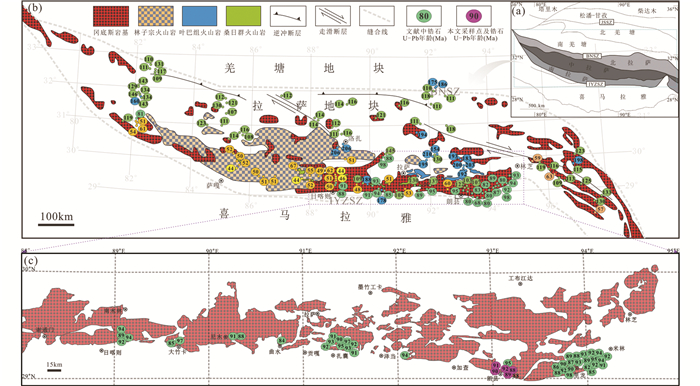
|
图 1 藏南冈底斯岩基东段朗县杂岩地质简图 (a)青藏高原大地构造单元划分图(据Zhu et al., 2011修改);(b)拉萨地块地质简图(据Chung et al., 2009修改), 锆石U-Pb数据引自Zhu et al., 2011, 2015, 2019及其文中参考文献;(c)冈底斯岩基中东部地质简图(据成都地质矿产研究所, 2004修改).JSSZ-金沙江缝合带;BNSZ-班公湖-怒江缝合带;IYZSZ-印度河-雅鲁藏布江缝合带 Fig. 1 Simplified geological map of Langxian Complex in the eastern part of Gangdese batholith, Southern Tibet (a) geological sketch map of tectonic outline of the Tibetan Plateau (after Zhu et al., 2011); (b) geological map of the Lhasa block (after Chung et al., 2009), data source of zircon U-Pb from Zhu et al., 2011, 2015, 2019 and references therein; (c) geological map of the studied area (after CIGMR, 2004). JSSZ-Jinsha Suture Zone; BNSZ-Bangong-Nujiang Suture Zone; IYZSZ-Indus-Yarlung Zangbo Suture Zone |
本文以朗县杂岩晚白垩世早期的岩浆岩为研究对象,开展锆石U-Pb年龄、全岩主要元素和微量元素研究,系统整理和对比已有的研究数据,进一步确定晚白垩世早期岩浆作用的性质、地球化学特征和岩石成因,借助锆石Hf同位素和全岩Sr-Nd同位素示踪岩浆源区,梳理清楚其岩石类型多样性的原因,着重探讨冈底斯晚白垩世早期岩浆作用形成的地球动力学背景。
1 地质背景和样品拉萨地块是青藏高原的重要组成部分,夹持于羌塘地块和喜马拉雅地块之间,南北以雅鲁藏布江缝合带和班公湖-怒江缝合带为构造界限,为一条整体呈东西向展布的巨型构造-岩浆岩带(图 1a; Yin and Harrison, 2000; Zhu et al., 2011)。拉萨地块依据狮泉河-纳木错混杂岩带(SNMZ)和洛巴堆-米拉山断裂带(LMF)进一步划分为北拉萨地块、中拉萨地块和南拉萨地块(图 1a; Zhu et al., 2011),其中,南拉萨地块主要由冈底斯岩基组成。冈底斯岩基的形成与新特提斯洋的北向俯冲(Wen et al., 2008a, b; Ji et al., 2009; 纪伟强等, 2009; 张泽明等, 2019; 徐倩等, 2019b; 高家昊等, 2017, 2020及其中参考文献)、印度/欧亚板块碰撞(Tapponnier et al., 1981; 莫宣学等, 2003; Chung et al., 2005)和碰撞后的深部动力学过程有关(Zhao et al., 2009; Guo and Wilson, 2019; Xu et al., 2020)。冈底斯岩基在漫长且复杂的演化过程中形成了各种类型的岩浆岩(Debon et al., 1986; Chung et al., 2005; Wen et al., 2008a, b; Ji et al., 2009; 张泽明等, 2019; Ma et al., 2018, 2020)。火山岩主要包括早-中侏罗世叶巴组火山岩(图 1b; Zhu et al., 2008; Liu et al., 2018),早侏罗世-早白垩世桑日群火山岩(图 1b; Zhu et al., 2009b; Kang et al., 2014)以及晚白垩世-始新世(68~43Ma)林子宗群火山岩(图 1b; He et al., 2007)。侵入岩主要包括辉长岩、辉绿岩、闪长岩、花岗闪长岩和花岗岩(Ji et al., 2009, 2014; 管琪等, 2010, 2011; Ma et al., 2013a, b, c; Zhang et al., 2014; Xu et al., 2015; 叶丽娟等, 2015; 徐倩等, 2019b; 高家昊等, 2017, 2020及其中参考文献)。晚三叠世-早白垩世侵入岩出露相对较少,以晚白垩世和新生代侵入岩为主,晚白垩世侵入岩的岩石类型丰富且出露范围广(图 1c; Wen et al., 2008a, b; Ji et al., 2009, 2014; Zhang et al., 2010; 黄玉等, 2010; 管琪等, 2010, 2011; Zhu et al., 2011; Ma et al., 2013a, b, c)而新生代的侵入岩则以钾质-超钾质岩浆岩(Zhao et al., 2009; Guo and Wilson, 2019)和高Sr/Y比中-酸性岩浆岩(Chung et al., 2003, 2005; Hou et al., 2004, 2015; 徐倩等, 2019a; Xu et al., 2020)为特征。
朗县杂岩位于冈底斯岩基东段(朗县县城)(图 1c),研究区从北向南出露3个构造单元,包括冈底斯岩基、雅鲁藏布江缝合带和特提斯喜马拉雅带(图 1b)。朗县杂岩内的沉积地层包括少量晚侏罗世多底沟组、白垩纪朗县混杂岩和渐新世-中新世大竹卡组(李广旭等, 2020, 2021)。朗县杂岩保存和记录多期岩浆作用过程,各期岩浆活动形成的岩浆岩主要包括泥盆纪-石炭纪花岗岩和花岗闪长岩(Ji et al., 2012a; 吴兴源等, 2013; 王莉等, 2013; Dong et al., 2014; 李广旭等, 2020),早白垩世闪长岩、花岗岩和岩脉(王莉等, 2013; 李广旭等, 2021),晚白垩世闪长岩、镁铁质包体和花岗岩(Quidelleur et al., 1997; Wen et al., 2008a, b; 管琪等, 2010; Zheng et al., 2014; 李广旭等, 2021),还出露始新世花岗岩(Guan et al., 2012; Ji et al., 2012b)。此外在朗县杂岩南部还发育一套“磨拉石”单元,即朗县砾岩,属于“冈仁波齐砾岩”的一部分(Aitchison et al., 2002; 董汉文等, 2016)。朗县砾岩主要由基质和砾石组成,均遭受了强烈的剪切变形。砾石主要由花岗岩(冈底斯岩基侵入岩)、火山岩和钾玄武玻璃等组成,部分粒度可达几米。砾石明显被剪切拉长,呈透镜状,指示向北逆冲的运动,年代学研究表明其物源主要为冈底斯岩基(董汉文等, 2016)。
采样地点位于朗县县城东部,样品包括:闪长岩(T0938-G、T0760-13S和T0760-15S)(图 2a, c)、花岗闪长岩(T0884)(图 2b)、花岗岩和花岗岩脉(T0883-LG和T0938-D)(图 2a),为晚白垩世早期侵入到朗县杂岩中,这些中酸性的侵入岩是朗县复式杂岩体的组成部分。闪长岩(T0760-13S和T0760-15S)出露于剪切带中(图 2c),具有明显的剪切变形。样品花岗岩砾石(T1075-2和T1075-3)采自朗县砾岩中,以巨型砾石的形式存在且遭受了强烈的变形(图 2d)。花岗岩脉(T0938-D)呈东西走向切穿围岩(图 2a)。
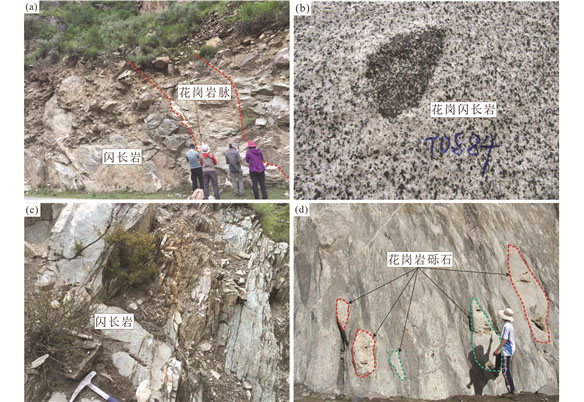
|
图 2 朗县杂岩晚白垩世早期岩浆岩野外露头 (a)闪长岩和花岗岩脉;(b)花岗闪长岩;(c)闪长岩(剪切变形);(d)朗县砾岩中花岗岩砾石 Fig. 2 Field photos of early Late Cretaceous magmatic rocks in Langxian Complex (a) diorites and granite dikes; (b) granodiorites; (c) shear deformed diorite; (d) granite gravel |
闪长岩(T0938-G)主要由斜长石(55%~60%)和角闪石(30%~35%)组成,含少量黑云母(~5%)和石英(~3%)(图 3a),副矿物以榍石为主,少量磷灰石和锆石。角闪石呈半自形粒状,为黄褐色或绿色(图 3a),有时可见石英充填其中;斜长石呈半自形板条状,颗粒较大(>1mm),具有明显的聚片双晶纹(图 3a),部分斜长石蚀变为绢云母。黑云母为淡褐色,片状,分布于角闪石边部。石英为他形,大小不一,具波状消光。
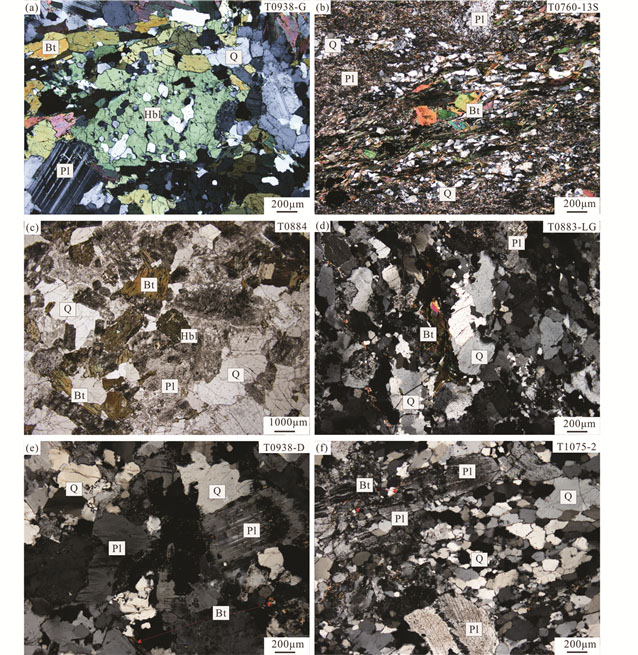
|
图 3 朗县杂岩晚白垩世早期岩浆岩显微照片 (a)闪长岩;(b)剪切变形的闪长岩;(c)花岗闪长岩;(d)花岗岩;(e)花岗岩脉;(f)花岗岩砾石. Q-石英;Pl-斜长石;Bt-黑云母;Hbl-角闪石 Fig. 3 Microphotographs of early Late Cretaceous magmatic rocks in Langxian Complex (a) diorite; (b) shear deformed diorite; (c) granodiorites; (d) granite; (e) granitic vein; (f) granite gravel. Q-quartz; Pl-plagioclase; Bt-biotite; Hbl-hornblende; Ap-apatite |
闪长岩(T0760-13S)主要由斜长石(50%~55%)、石英(20%~25%)、角闪石(15%~20%)、黑云母(5%)、方解石(5%)和少量的锆石、榍石、磷灰石等组成(图 3b)。所有矿物均发生强烈的剪切变形,具明显的定向性。斜长石破碎,可见明显的蚀变现象,蚀变为碳酸岩矿物(图 3b);石英为他形粒状,粒度不均,呈条带状,可见波状消光(图 3d);角闪石主要为绿色或褐色,半自形长柱状晶体,部分蚀变为绿帘石。
花岗闪长岩(T0884)主要由石英(45%~50%)、斜长石和钾长石(35%~40%)、角闪石和黑云母(10%~15%)组成(图 3c),副矿物有榍石、锆石和磷灰石等。石英为他形,颗粒较大,具波状消光。斜长石形态不规则,具有明显的熔蚀现象(图 3c),钾长石可见条纹或出溶现象;角闪石主要为绿色,半自形长柱状晶体,多数发生蚀变但可见原有晶形(图 3c),蚀变为绿帘石。黑云母为褐色,片状。
花岗岩和花岗岩脉(T0883-LG和T0938-D)主要由斜长石和钾长石(50%~60%)、石英(30%~35%)和黑云母(1%~5%)组成,偶见角闪石。副矿物包括锆石和磷灰石等。斜长石呈半自形板条状,具有明显的聚片双晶纹。石英无规则形状,波状消光(图 3d, e)。
花岗岩砾石(T1075-2和T1075-3)的矿物组成和结构相似,主要由斜长石和钾长石(45%~50%)、石英(40%~45%)和黑云母(3%~5%)组成。副矿物有锆石、榍石和磷灰石等。石英颗粒较大(500μm),不规则,波状消光(图 3f)。钾长石具有明显的蚀变现象,黑云母呈团簇分布(图 3f)。
3 分析方法 3.1 全岩地球化学分析为了解藏南冈底斯岩基东段朗县杂岩中晚白垩世早期岩浆岩的全岩元素地球化学特征,在自然资源部国家地质实验测试中心开展了研究样品的全岩元素组成的测试工作。主量元素利用X荧光光谱仪3080E(XRF)进行分析测试,测试分析精度为5%;微量和稀土元素(REE)利用等离子质谱仪(ICP-MS-Excell)进行测试,对于含量大于10×10-6的元素,分析精度为5%,含量小于10×10-6的元素,精度为10%,样品中个别含量低的元素测试误差大于10%。
3.2 锆石U-Pb定年为确定朗县杂岩中晚白垩世早期岩浆岩的形成时代,通过对研究样品进行粉碎并手工挑选锆石,利用锆石U-Pb法进行测年。具体流程见李广旭等(2020, 2021)。
朗县杂岩采集的4件研究样品(T0760-13S、T0884、T1075-2和T1075-3)的LA-MC-ICP-MS锆石U-Pb定年测试工作在中国地质科学院矿产资源研究所成矿作用与资源评价重点实验室完成,测试仪器为德国Finnigan公司生产的Neptune型激光多接收等离子体质谱(LA-MC-ICPMS)。激光剥蚀系统采用美国NEW Wave公司生产的UP213nm,激光斑束直径为25μm,频率为10Hz,能量密度约为2.5J/cm2,以He为载气。以锆石标样M127(U=923×10-6; Th/U=0.475)为外标进行U和Th含量校正。在具体测试过程中,每测定10个样品点前后重复测量两次锆石标样GJ-1和一次锆石标样Plesovice。利用软件ICPMSDataCal完成数据的处理(Liu et al., 2010)。
朗县杂岩2件研究样品(T0760-15S和T0883-LG)的锆石U-Pb定年分析在国家地质实验测试中心LA-ICP-MS实验室完成。激光剥蚀-电感耦合等离子体质谱仪(LA-ICP-MS)分析设备由NEW WAVE esi 193nm激光剥蚀系统和Thermo ELMENT XR扇形磁场高分辨质谱仪组成。激光剥蚀系统以He作为剥蚀物质传输载气,激光斑束直径为25μm,频率为10Hz,输出能量约为8mJ;单点分析包括气体背景采集时间20s,激光剥蚀锆石信号采集时间40s及剥蚀后吹扫时间20s。每10个未知样品点分析插入国际标准锆石样品91500(2点)及Plesovice(1点)。同位素比值数据处理采用GLITTER(Version 4.0)完成,年龄计算采用ISOPLOT进行。
朗县杂岩中一件闪长岩(T0938-G)和一件花岗岩脉(T0938-D)利用SHRIMP锆石U-Pb定年方法进行测试分析,在北京离子探针中心完成相关测试工作,所用仪器为高分辨率、高灵敏度离子探针SHRIMP Ⅱ。分析时所用标样为TEM锆石,每测定3个样品点,进行一次标样测定,以便及时校正,保障测试精度。数据分析处理和年龄计算等利用ISOPLOT程序(Ludwig, 2003)。
3.3 锆石Hf同位素测试样品的锆石Hf同位素测试工作在中国地质科学院矿产资源研究所自然资源部成矿作用与资源评价重点实验室完成。实验相关仪器为Neptune多接收等离子质谱和Newwave UP213紫外激光剥蚀系统(LA-MC-ICP-MS),实验过程中以He作为剥蚀物质载气,剥蚀直径采用40μm,测试过程中使用锆石国际标样GJ1和Plesovice作为参考物质,测试分析点与锆石U-Pb定年测试点位保持一致。相关仪器运行条件及详细分析流程见侯可军等(2007)。分析过程中锆石标准GJ1和Plesovice的176Hf/177Hf测试加权平均值分别为0.282007±0.000007(2σ,n=36)和0.282476±0.000004(2σ,n=27),均在误差范围内。
3.4 全岩Sr-Nd同位素测试对朗县杂岩采集的样品进行Rb-Sr和Sm-Nd同位素分析,具体测试工作在中国科学技术大学放射性同位素地球化学实验室完成,实验采用同位素稀释法,利用热电离质谱仪MAT-26分析测试完成。其中样品的化学分离纯化在净化实验室完成。Sr和Nd同位素比值分析结果分别采用86Sr/88Sr=0.1194和146Nd/144Nd=0.7219进行质量分馏标准化校正。在分析样品的过程中,Sr同位素监测标样采用NBS987,测定值为87Sr/86Sr=0.710249±0.000012(2σ,n=38),Nd同位素监测标样为La Jolla,测定值为143Nd/144Nd=0.511869±0.000006(2σ,n=25)。实验过程中具体的分析方法和流程参见Chen et al. (2002, 2007)。依据已获得的朗县杂岩中样品的锆石U-Pb定年结果,分别计算初始Sr和Nd同位素比值。
4 数据及结果 4.1 全岩地球化学特征 4.1.1 主量元素特征闪长岩(T0938-G)的SiO2含量变化较小(57.31%~59.58%)(表 1、图 4),Fe2O3T含量为7.07%~7.34%,MgO含量为3.19%~3.40%,Mg#为46.8~48.2,TiO2和MnO含量较低,分别 < 0.90%和 < 0.14%,Na2O含量为3.48%~3.95%、K2O含量为1.76%~2.80%,Na2O/K2O均>1.0(1.27~2.24)(图 5d),CaO含量相对变化较小(5.90%~6.45%),Al2O3含量较高,为16.06~17.33%(图 4a),铝饱和指数(A/CNK)较低为0.81~0.87,TAS图解上显示为闪长岩,具有高钾钙碱性偏铝质的特征(图 5)。
|
|
表 1 冈底斯岩基朗县杂岩晚白垩世早期岩浆岩全岩地球化学数据(主量元素:wt%;稀土和微量元素:×10-6) Table 1 Whole rock geochemical data of early Late Cretaceous magmatic rocks from Langxian Complex in the Gangdese batholith (Major elements: wt%; Trace elements: ×10-6) |
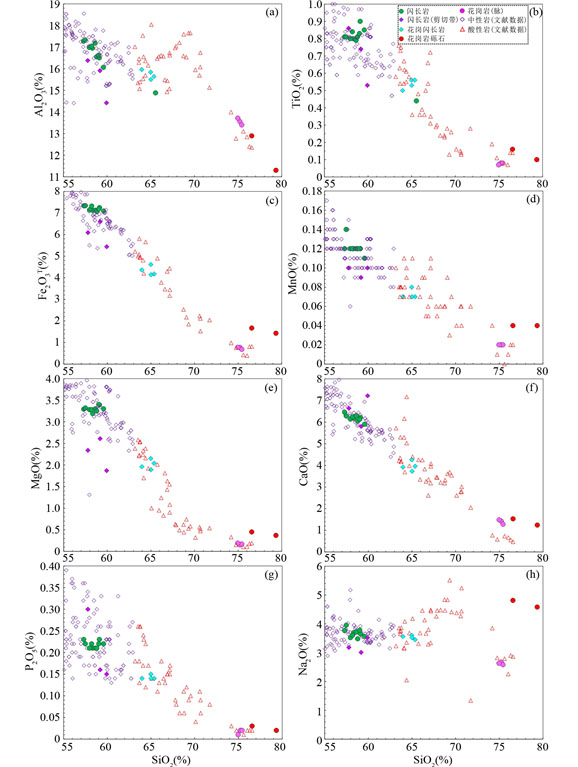
|
图 4 朗县杂岩晚白垩世早期岩浆岩地球化学特征 文献数据引自Zhang et al., 2014; 管琪等, 2010, 2011; Jiang et al., 2012, 2014; Ji et al., 2014; Ma et al., 2013a, b, c; Zheng et al., 2014; Xu et al., 2015; 叶丽娟等, 2015; 徐倩等, 2019b; 高家昊等, 2020;图 6、图 9、图 10同 Fig. 4 Covariation diagram of selected major oxides of Al2O3, TiO, Fe2O3T, MgO, MnO, CaO, P2O5, Na2O against SiO2 in early Late Cretaceous magmatic rocks of Langxian Complex Literature data after Zhang et al., 2014; Guan et al., 2010, 2011; Jiang et al., 2012, 2014; Ji et al., 2014; Ma et al., 2013a, b, c; Zheng et al., 2014; Xu et al., 2015, 2019; Ye et al., 2015; Gao et al., 2020; also in Fig. 6, Fig. 9 and Fig. 10 |
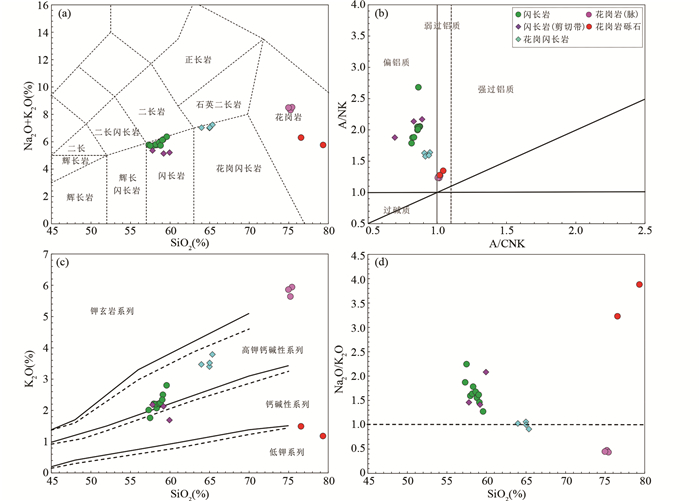
|
图 5 冈底斯岩基东段朗县杂岩晚白垩世早期岩浆岩地球化学特征图解 (a) TAS分类图解(据Middlemost, 1994);(b) A/CNK-A/NK图解(据Maniar and Piccoli, 1989);(c) SiO2-K2O图解(据Rollinson, 1993);(d) SiO2-Na2O/K2O图解 Fig. 5 Geochemical diagrams of early Late Cretaceous magmatic rocks in Langxian Complex of Gangdese batholiths (a) Total alkalis vs. silica diagram (after Middlemost, 1994); (b) A/NK vs. A/CNK diagram for the granitic rocks (after Maniar and Piccoli, 1989); (c) K2O vs. SiO2 diagram for classification of rock series (after Rollinson, 1993) (d) SiO2 vs. Na2O/K2O diagram |
闪长岩(T0760-13S)的SiO2含量变化较小(57.78%~59.93%),Fe2O3T含量为5.44%~6.60%,MgO含量为1.87%~2.61%(图 4),Mg#为40.5~43.8,TiO2和MnO含量分别 < 0.86%和 < 0.10%,Na2O含量为3.01%~3.52%、K2O含量为1.69%~2.18%,Na2O/K2O较高,均>1(1.41~2.08),CaO含量相对变化较小(5.80%~7.22%),Al2O3含量为14.42%~16.38%,铝饱和指数(A/CNK)为0.69~0.89,TAS图解上显示为闪长岩,具有高钾钙碱性偏铝质的特征(图 5)。
花岗闪长岩(T0884)的SiO2含量较低(63.97%~65.36%)、Al2O3含量为15.50%~15.96%,铝饱和指数(A/CNK=0.91~0.95),Na2O含量(3.45%~3.60%)、K2O含量3.40%~3.79%,CaO含量(3.73%~4.26%),Fe2O3T含量(4.14%~4.61%)和MgO含量(1.89%~2.15%),Mg#=46.9~49.0(表 1),TiO2和MnO含量分别 < 0.56%和 < 0.08%,表现为高钾钙碱性偏铝质特征(图 5)。
花岗岩(T0938-D和T0883-LG)中SiO2含量(74.97%~75.42%)、Na2O含量(2.58%~2.67%)、K2O含量(5.64%~5.94%),Na2O/K2O低,均 < 1(0.43~0.47),CaO含量(1.28%~1.48%),Fe2O3T和MgO的平均含量分别为0.74%和0.17%,TiO2和MnO含量较低,分别 < 0.08%和 < 0.02%,Al2O3含量为13.40%~13.71%(图 4a),铝饱和指数(A/CNK=1.01~1.02),具有高钾钙碱性弱过铝质特征(图 5)。
花岗岩砾石(T1075)中SiO2含量为76.56%和79.34%、Na2O含量为4.81%和4.58%(图 4)、K2O含量为1.49%和1.18%,Na2O/K2O较高,均>3(3.23和3.88),CaO含量(1.53%和1.24%),Fe2O3T和MgO的平均含量分别为1.55%和0.41%,TiO2和MnO含量较低,分别 < 0.16%和 < 0.04%,Al2O3含量为12.89%和11.30%,铝饱和指数(A/CNK=1.04和1.02),表现为低钾弱过铝质特征(图 5)。
4.1.2 微量元素特征闪长岩(T0938-G)富集大离子亲石元素(如Cs、Rb和Pb),Sr微弱亏损;高场强元素Th和U富集,Nb和Zr轻微亏损,但Hf无明显异常(图 6;表 1);Ti微弱亏损。Sr含量较高(430×10-6~503×10-6),Y含量较低(19.3×10-6~22.4×10-6),Sr/Y=19.2~26.0,Cr含量为13.3×10-6~32.0×10-6,Ni含量为13.3×10-6~18.5×10-6(表 1)。

|
图 6 朗县杂岩晚白垩世早期岩浆岩球粒陨石标准化稀土元素模式图(a)和原始地幔标准化微量元素蜘蛛图(b)(标准化值据McDonough and Sun, 1995) Fig. 6 Chondrite-normalized REE patterns (a) and primitive mantle-normalized trace element spider diagrams (b) of early Late Cretaceous magmatic rocks of Langxian Complex (normalization values after McDonough and Sun, 1995) |
闪长岩(T0760-13S)同样富集大离子亲石元素(如Cs、Rb和Pb),Sr微弱亏损;高场强元素Th和U富集,Nb亏损,Zr和Hf无异常(表 1、图 6),Sr含量高和Y含量较低,分别为406×10-6~535×10-6和13.3×10-6~24.0×10-6,Sr/Y=22.3~36.9,Cr含量为26.1×10-6和27.6×10-6,Ni含量为14.6×10-6~18.7×10-6(表 1)。
花岗闪长岩(T0884)明显富集大离子亲石元素(如Cs、Rb、K、Ba和Pb)和高场强元素Th和U,Nb亏损,Zr和Hf无明显异常,Ti强烈亏损,(表 1、图 6),Sr和Y含量分别为396×10-6~423×10-6和16.3×10-6~21.2×10-6,Sr/Y=18.7~26.0,Cr含量为22.8×10-6和52.8×10-6,Ni含量为13.0×10-6~23.5×10-6(表 1)。
花岗岩(T0938-D和T0883-LG)富集大离子亲石元素(如Cs、Rb、K、Ba和Pb)和高场强元素(如Th和U);高场强元素Nb、Ta亏损,Ti强烈亏损,Zr无明显异常,Hf正异常(表 1、图 6),具有微弱Eu负异常(Eu/Eu*=0.88~1.12);Sr和Y含量较低分别为155×10-6~168×10-6和Y含量为2.80×10-6~4.97×10-6,Sr/Y=33.8~55.4。Cr含量为1.18×10-6~10.1×10-6,Ni含量较低为1.27×10-6~3.83×10-6(表 1);
花岗岩砾石(T1075)微量元素具有相似的特征,高场强元素Nb亏损,Ti强烈亏损,Zr无明显异常,Hf正异常(表 1、图 6),Eu负异常(Eu/Eu*=0.35和0.40)(表 1),其Sr含量为115×10-6和132×10-6,Y含量为21.1×10-6和18.4×10-6,Sr/Y=5.5和7.2。Cr含量为2.03×10-6和3.26×10-6,但花岗岩砾石样品中Ni含量偏高为12.1×10-6和13.6×10-6(表 1);
4.1.3 稀土元素特征闪长岩(T0938-G)和闪长岩(T0760-13S)具有相似的稀土分布特征,稀土总量为∑REE=91.0×10-6~141.8×10-6,样品轻微富集轻稀土元素,重稀土元素相对亏损(表 1、图 6),从Gd-Yb稀土分布平坦,具有较弱的负Eu异常(Eu/Eu*=0.70~0.95),轻重稀土分异不明显(图 6)。
花岗闪长岩(T0884)具有较高的稀土总量∑REE=131.3×10-6~148.9×10-6,样品轻微富集轻稀土元素,重稀土元素相对亏损(表 1、图 6),从Gd-Yb稀土分布平坦,具有弱的负Eu异常(Eu/Eu*=0.61~0.66),轻重稀土分异不明显(图 6)。
花岗岩(T0938-D和T0883-LG)稀土总量较低∑REE=39.0×10-6~59.4×10-6,样品富集轻稀土元素,亏损重稀土元素(表 1、图 6),从Gd-Yb稀土分布较为平坦,具有微弱Eu负异常(Eu/Eu*=0.88~1.12),轻重稀土分异较为明显(图 6)。
花岗岩砾石(T1075)稀土总量较高∑REE=138.5×10-6和170.3×10-6,样品富集轻稀土元素,亏损重稀土元素(表 1、图 6),从Gd-Yb稀土分布较为平坦,花岗岩砾石具有明显的Eu负异常(Eu/Eu*=0.35和0.40),轻重稀土分异明显(图 6)。
4.2 锆石U-Pb年龄本文对朗县杂岩中8件样品进行了锆石U-Pb定年,分析结果见表 2和表 3。
|
|
表 2 冈底斯岩基东段朗县杂岩晚白垩世早期岩浆岩SHRIMP锆石U-Pb定年数据 Table 2 SHRIMP zircon U-Pb analytical results of early Late Cretaceous magmatic rocks from Langxian Complex in the Gangdese batholith, southern Tibet |
|
|
表 3 冈底斯岩基东段朗县杂岩晚白垩世早期岩浆岩LA-MC-ICP-MS锆石U-Pb定年数据 Table 3 LA-MC-ICP-MS zircon U-Pb analytical results of early Late Cretaceous magmatic rocks from Langxian Complex in the Gangdese batholith, southern Tibet |
闪长岩(T0938-G)中的锆石为长柱状或板状,长宽比为2:1,粒度为200μm,为宽板状(图 7a),锆石的Th和U含量变化范围分别为76.1×10-6~702.9×10-6和131.7×10-6~1426×10-6,Th/U比值变化范围分别为0.41~1.23(表 2)。测试分析12个点,加权平均年龄为92.4±1.4Ma(12个分析点,MSWD=1.30)(图 8a)。
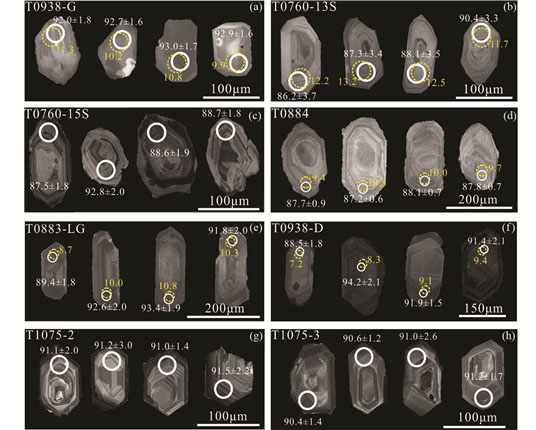
|
图 7 朗县杂岩晚白垩世早期岩浆岩中锆石阴极发光图像(CL)和U-Pb定年结果(Ma) 实线圆圈代表年龄测试分析点,虚线圆圈代表Hf同位素测试分析点 Fig. 7 Cathodoluminescence (CL) images and U-Pb (Ma) analysis on zircon grains in early Late Cretaceous magmatic rocks of Langxian Complex of eastern Gangdese batholith Solid and dashed circles show the locations of U-Pb dating and Hf analyses, respectively |
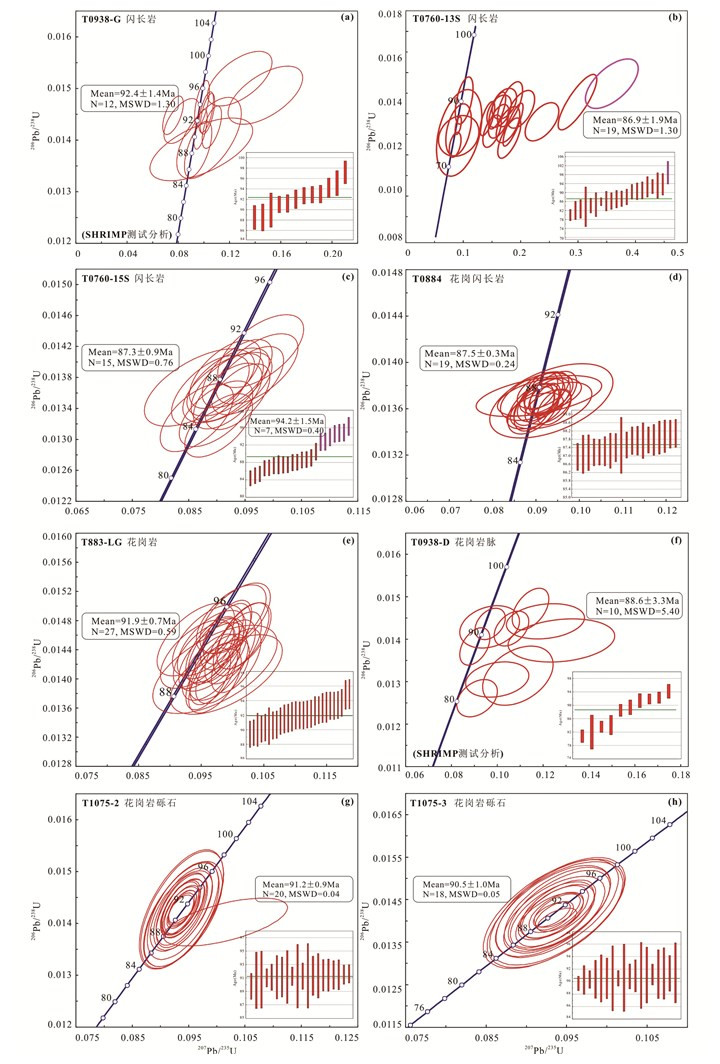
|
图 8 朗县杂岩晚白垩世早期岩浆岩锆石U-Pb年龄谐和图和年龄分布图 Fig. 8 U-Pb concordia and age distribution diagrams for zircon in early Late Cretaceous magmatic rocks of Langxian Complex of eastern Gangdese batholith |
闪长岩(T0760-13S和T0760-15S)中的锆石具有相似特征,发育振荡环带,粒度较小(100μm)(图 7b, c)。Th含量变化范围分别为133.2×10-6~896.4×10-6和59.9×10-6~1681×10-6,U含量变化范围为119.2×10-6~3466×10-6和92.0×10-6~1341×10-6,Th/U比值变化范围分别为0.26~1.30和0.56~1.51(表 3)。T0760-13S样品测试分析20个点,206Pb/238U年龄变化较小,剔除一个不谐和年龄,加权平均年龄为86.9±1.9Ma(19个分析点,MSWD=1.30)(图 8b、表 3)。T0760-15S样品测试分析25个点,剔除2个谐和度较低的测试点,206Pb/238U年龄进一步划分为两组,较年轻的加权平均年龄为87.3±0.9Ma(15个分析点,MSWD=0.76)(图 8c、表 3),较老的加权平均年龄为94.2±1.5Ma(7个分析点,MSWD=0.40)(图 8c、表 3),此外一个测试点获得的年龄为103.1±2.1Ma。
花岗闪长岩(T0884)中的锆石为长柱状,发育振荡环带(图 7d),Th和U含量变化范围较小,分别为312.6×10-6~942.8×10-6和278.7×10-6~684.3×10-6,Th/U比值为0.59~1.70(表 3)。样品测试分析20个点,其中19个点获得的206Pb/238U年龄变化较小,加权平均年龄为87.5±0.3Ma(19个分析点,MSWD=0.24)(图 8d、表 3),剩余1个测点给出的206Pb/238U年龄为91.5±0.7Ma(表 3)。
花岗岩脉(T0883-LG)样品锆石为长柱状,长宽比为2:1,颗粒大小为200μm,具明显的振荡环带(图 7e),Th和U含量变化分别为70.2×10-6~4715×10-6和114.4×10-6~4163×10-6,Th/U比值为0.09~1.59(表 3)。测试分析30个点,去掉谐和度较低的3个测试点,剩余27个点获得的206Pb/238U年龄变化较小,加权平均年龄为91.9±0.7Ma(27个分析点,MSWD=0.59)(图 8e、表 3)。
花岗岩脉(T0938-D)样品锆石为长柱状,长宽比为2:1,颗粒大小为150μm,具振荡环带(图 7f),Th和U含量变化分别为87.0×10-6~574.8×10-6和259.5×10-6~1265×10-6,Th/U比值为0.26~2.20(表 2)。测试分析12个点,其中10个点获得的206Pb/238U年龄变化较小,加权平均年龄为88.6±3.3Ma(10个分析点,MSWD=5.40)(图 8f、表 2),其中2个测点的206Pb/238U年龄分别为241.9Ma和1353.0Ma(表 2)。
花岗岩砾石(T1075-2和T1075-3)中锆石同样发育振荡环带(图 7g, h),Th和U含量变化均很大,Th含量变化范围分别为597.6×10-6~2292×10-6和188.5×10-6~2194×10-6,U含量变化范围分别为795.9×10-6~2947×10-6和910.5×10-6~2225×10-6,Th/U比值为0.59~1.08和0.16~1.15(表 3)。样品T1075-2和T1075-3获得的206Pb/238U年龄变化较小,年龄集中在谐和线~90Ma附近,加权平均年龄分别为91.2±0.9Ma(20个分析点,MSWD=0.04)和90.5±1.0Ma(18个分析点,MSWD=0.05)(图 8g, h)。样品T1075-3有两个测试点获得的年龄为116.1Ma和366.4Ma(表 3)。
上述8件样品的锆石U-Pb定年测试结果表明,朗县杂岩中出露的闪长岩、花岗闪长岩岩和花岗岩(脉体)的结晶年龄集中晚白垩世早期(94~87Ma)。闪长岩(T0760-15S)记录了~94Ma和~87Ma两个阶段的岩浆作用。此外,朗县杂岩存在古老地壳物质,部分样品中获得的锆石U-Pb定年结果显示具有较老的年龄记录,这些锆石为捕获或继承锆石。
4.3 锆石Hf同位素特征闪长岩(T0938-G)样品中19个点的176Lu/177Hf值为0.000368~0.001062,176Hf/177Hf(t)值为0.282987~0.283076(表 4),εHf(t)值为+9.6~+12.8(表 4、图 9a),平均值为+10.9,亏损地幔模式年龄(tDM)为246~371Ma,平均地壳模式年龄(tDMC)为339~542Ma(表 4)。
|
|
表 4 冈底斯岩基东段朗县杂岩晚白垩世早期岩浆岩的锆石Hf同位素测试结果 Table 4 Analysis results of zircon Hf isotopic compositions of early Late Cretaceous magmatic rocks in Langxian Complex, eastern Gangdese |
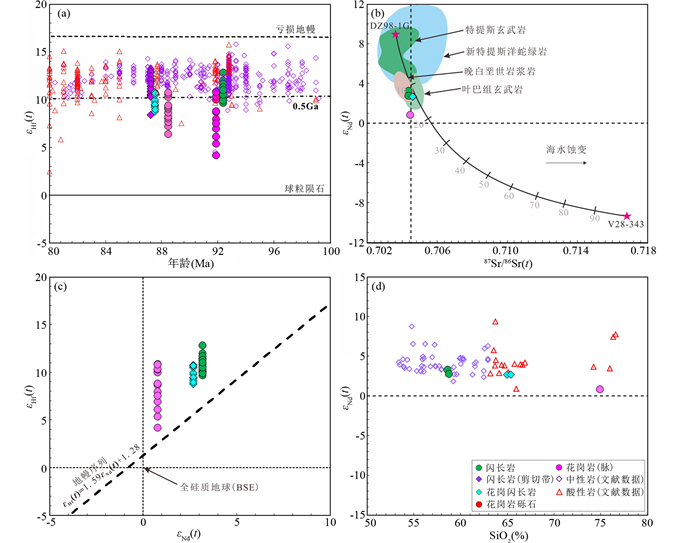
|
图 9 朗县杂岩晚白垩世早期岩浆岩εHf(t)-年龄(a)、εNd(t)-87Sr/86Sr (b)、εHf(t)-εNd(t) (c)和εNd(t)-SiO2 (d)关系图解 资料来源:叶巴组玄武岩,Zhu et al., 2008;特提斯玄武岩,Mahoney et al., 1998;新特提斯洋蛇绿岩及样品DZ98-1G(Nd=6.66×10-6,εNd(t)=8.9,Sr=180.7×10-6,87Sr/86Sr(t)=0.70354),Mahoney et al., 1998; Xu and Castillo, 2004; Zhang et al., 2005;印度洋深海沉积物及样品V28-343(Nd=23.05×10-6,εNd(t)=-9.3,Sr=119×10-6,87Sr/86Sr(t)=0.71682),Othman et al., 1989 Fig. 9 Plots of εHf(t) vs. U-Pb age (a), εNd(t) vs. 87Sr/86Sr(t) (b), εHf(t) vs. εNd(t) (c) and εNd(t) vs. SiO2 (d) for early Late Cretaceous magmatic rocks of Langxian Complex of eastern Gangdese batholith Data resources: Yeba Formation basalt, Zhu et al., 2008; Tethyan basalt, Mahoney et al., 1998; Neo-Tethys ophiolites DZ98-1G (Nd=6.66×10-6, εNd(t)=8.9, Sr=180.7×10-6, 87Sr/86Sr(t)=0.70354), Mahoney et al., 1998; Xu and Castillo, 2004; Zhang et al., 2005; Indian Ocean pelagic sediment V28-343 (Nd=23.05×10-6, εNd(t)=-9.3, Sr=119×10-6, 87Sr/86Sr(t)=0.71682), Othman et al., 1989 |
闪长岩(T0760-13S)样品中的锆石的Hf同位素特征如下:20个点的176Lu/177Hf值为0.000405~0.001235,176Hf/177Hf(t)值为0.282955~0.283090(表 4),εHf(t)值为+8.3~+13.2(图 9a、表 4),平均值为+11.6,亏损地幔模式年龄(tDM)为225~416Ma,平均地壳模式年龄(tDMC)为310~620Ma(表 4)。
花岗闪长岩(T0884)样品中锆石的Hf同位素特征为14个点的176Lu/177Hf值为0.000461~0.000906,176Hf/177Hf(t)值为0.282965~0.283023,εHf(t)=+8.7~+10.8(图 9a、表 4),平均值为+9.9,亏损地幔模式年龄(tDM)为320~403Ma,平均地壳模式年龄(tDMC)为463~594Ma(表 4)。
花岗岩脉(T0938-D)样品中13个点的176Lu/177Hf值为0.000734和0.002344,176Hf/177Hf(t)值为0.282897~0.283019,εHf(t)为+6.4~+10.7平均值为+8.7,(图 9a、表 4),亏损地幔模式年龄(tDM)为326~509Ma,平均地壳模式年龄(tDMC)为470~748Ma(表 4)。
花岗岩(T0883-LG)样品中15个点的176Lu/177Hf值为0.000526~0.003070,176Hf/177Hf(t)值为0.282831~0.283020,εHf(t)=为+4.1~+10.8(平均值为+8.3)(图 9a、表 4),亏损地幔模式年龄(tDM)为330~610Ma,平均地壳模式年龄(tDMC)为465~893Ma(表 4)。
朗县杂岩中的闪长岩和花岗闪长岩具有较高且正的锆石Hf同位素组成,但花岗岩样品的锆石Hf同位素组成则偏低,变化范围较大,总体显示随着SiO2的升高而降低。早期和晚期(92Ma和87Ma)的闪长岩锆石Hf同位素基本一致,但晚期花岗岩闪长岩则偏低。早期和晚期的花岗岩锆石Hf同位素组成变化较小。
4.4 全岩Sr-Nd同位素特征朗县杂岩中样品的全岩Sr-Nd同位素比值根据样品测得的加权平均年龄计算。全岩Sr-Nd同位素组成数据见表 5,具体特征如下:
|
|
表 5 冈底斯岩基东段朗县杂岩晚白垩世早期岩浆岩的全岩Sr-Nd同位素测试结果 Table 5 Analysis results of whole-rock Sr-Nd isotopic compositions of early Late Cretaceous magmatic rocks in Langxian Complex, eastern Gangdese |
闪长岩(T0883-4和T0883-5)的Rb和Sr含量分别为83.6×10-6和97.1×10-6,501×10-6和491×10-6,Rb/Sr比值为0.483和0.572;Sm和Nd的含量分别为3.76×10-6和4.47×10-6和20.3×10-6和20.9×10-6,Sm/Nd比值为0.1120和0.1293(表 5)。样品的初始87Sr/86Sr(t)同位素比值为0.704384和0.704374,εNd(t)分别为+3.2和+2.7(图 9b, d、表 5)。一阶段模式年龄为tDM1为595Ma和745Ma,二阶段模式年龄为tDM2为627Ma和676Ma(表 5)。
花岗闪长岩(T0884-1和T0884-2)的Rb和Sr含量分别为160×10-6和185×10-6和396×10-6和403×10-6,Sm和Nd的含量为4.92×10-6和5.05×10-6和25.5×10-6和25.7×10-6,Rb/Sr比值较高(1.169~1.328),Sm/Nd比值较低(均为0.1),样品的初始87Sr/86Sr(t)同位素比值为0.704631和0.704596(表 5),εNd(t)均为+2.7(图 9b, d、表 5)。一阶段模式年龄为tDM1为662Ma和673Ma,二阶段模式年龄均为tDM1=672Ma(表 5)。
花岗岩(T0883-2)的Rb和Sr含量分别为161×10-6和155×10-6,Rb/Sr比值为3.005。Sm和Nd的含量为1.22×10-6和8.82×10-6,Sm/Nd比值为0.0836,样品的初始87Sr/86Sr(t)同位素比值为0.704490,εNd(t)为+0.8(图 9b, d、表 5)。一阶段模式年龄为tDM1=632Ma,二阶段模式年龄为tDM2=816Ma(表 5)。
5 讨论 5.1 冈底斯岩基晚白垩世早期岩浆作用的特点冈底斯岩基晚白垩世(100~73Ma)岩浆作用非常广泛且强烈,其峰期岩浆作用出现在95~85Ma之间,被认为是“岩浆爆发”事件(Wen et al., 2008a, b; 纪伟强等, 2009; Zhang et al., 2010; 黄玉等, 2010; 管琪等, 2010, 2011; Zhu et al., 2011; Ma et al., 2013a, b, c; Ji et al., 2014)。该时间段的岩浆岩是冈底斯岩基的主要组成部分,自西向东出露在南木林、尼木、曲水、拉萨、松卡、正嘎、朗县、里龙和米林等地区(Wen et al., 2008a, b; 纪伟强等, 2009; 管琪等, 2010, 2011; Ma et al., 2013a)。集中分布在冈底斯岩基的东部(朗县至米林地区)(Quidelleur et al., 1997; Zhang et al., 2010; 管琪等, 2010, 2011; Zhu et al., 2011; Ma et al., 2013a, b, c; Zheng et al., 2014; 高家昊等, 2020),一部分出露于冈底斯岩基中部的拉萨-南木林一带(Ji et al., 2009, 2014; 黄玉等, 2010; 叶丽娟等, 2015; Xu et al., 2015; 高家昊等, 2017; 徐倩等, 2019b)(图 1c)。通过系统汇总已报道的冈底斯岩基晚白垩世岩浆岩的数据,将晚白垩世岩浆作用进一步划分为早期和晚期,早期(100~85Ma)以中基性镁铁质岩浆作用为主(Quidelleur et al., 1997; Zhang et al., 2010; 管琪等, 2010, 2011; Zhu et al., 2011; Ma et al., 2013a, b, c; Zheng et al., 2014; 叶丽娟等, 2015; Xu et al., 2015; 徐倩等, 2019b; 高家昊等, 2020);晚期(85~73Ma)岩浆作用主要为中酸性岩浆作用(Ji et al., 2009, 2014; 黄玉等, 2010; 管琪等, 2011; 叶丽娟等, 2015; Xu et al., 2015)。在岩石类型上早期(100~85Ma)岩浆活动比晚期(85~73Ma)丰富。
冈底斯岩基晚白垩世早期(100~85Ma)岩浆岩类型较丰富,主要由中基性岩石(镁铁质岩石)组成,包括苏长岩、辉长-辉绿岩、角闪石岩、闪长岩、石英闪长岩和花岗闪长岩(Wen et al., 2008a; 管琪等, 2010, 2011; Ma et al., 2013a, b, c; Zheng et al., 2014; Ji et al., 2014; Xu et al., 2015; 叶丽娟等, 2015; 徐倩等, 2019b; 高家昊等, 2020),此外还出露紫苏花岗岩(Zhang et al., 2010; Ma et al., 2013b)和不同成因的埃达克质岩浆岩,例如埃达克质紫苏花岗岩(洋中脊或俯冲洋壳部分熔融成因)(Zhang et al., 2010; Ma et al., 2013b)、埃达克质闪长岩和花岗闪长岩(熔体交代俯冲洋壳部分熔融成因)(Jiang et al., 2012, 2014; Zheng et al., 2014; 徐倩等, 2019b)、埃达克质花岗岩(增厚镁铁质下地壳部分熔融成因)(Wen et al., 2008a; 管琪等, 2010)和埃达克质闪长岩和花岗闪长岩(角闪石为主的分离结晶作用成因)(Xu et al., 2015)。
总体来讲,冈底斯岩基晚白垩世的岩浆岩以较大岩体的形式广泛出露于拉萨地块南部,各种岩浆岩的年龄跨度非常小且呈“爆发”式产出,其持续时间近30Myr,岩浆作用的形式复杂多样,表现为规模大、岩浆源区不均一、多种形成机制和岩石类型丰富等。朗县杂岩中的闪长岩、花岗闪长岩和花岗岩的锆石U-Pb年龄数据表明该杂岩存在晚白垩世岩浆作用,属于冈底斯岩基晚白垩世“岩浆爆发”时期的产物,进一步说明晚白垩世岩浆活动非常活跃。
5.2 岩石成因和岩浆源区朗县杂岩晚白垩世早期闪长岩具有正的全岩εNd(t)(+3.2/+2.7)和较低的初始87Sr/86Sr(t)(0.704384和0.704374)同位素比值(图 9b),同时两件闪长岩样品的锆石εHf(t)=+8.3~+13.2(图 9a)。花岗闪长岩获得了一致的全岩εNd(t)(均为+2.7),初始87Sr/86Sr(t)为0.704631和0.704596(图 9b),锆石εHf(t)为+8.7~+10.8(图 9a)。闪长岩和花岗闪长岩具有相似的Sr-Nd-Hf同位素特征(图 9a, b),此外主量元素随着SiO2含量的增加具有连续的演化趋势(图 4),闪长岩和花岗闪长岩的具有相似的微量元素组成均富集LREE、LILE和HFSE(图 5),表明两者具有相同或相似的岩浆源区,即来自于亏损的地幔源区,但锆石εHf(t)变化范围在5个ε单位以及明显偏低的全岩εNd(t)暗示源区组成的不均一性(图 9a, b)。岩浆源区的不均一很有可能是受到来自地壳物质或沉积物派生的流体的混染所致,这些特征与已报道的冈底斯岩基的晚白垩世早期岩浆岩基本一致(Wen et al., 2008a; 管琪等, 2010, 2011; Jiang et al., 2012, 2014; Ma et al., 2013a, b, c; Zhang et al., 2010; Zheng et al., 2014; Ji et al., 2014; Xu et al., 2015; 叶丽娟等, 2015; 高家昊等, 2020),因此具有亏损性质的地幔楔是其可能的岩浆源区。
样品的全岩εNd(t)与SiO2含量之间没有明显的线性关系(图 9d),表明这些岩浆岩未受地壳混染的影响。闪长岩和花岗岩闪长岩具有较低的Nb/U(1.9~3.7)和Ce/Pb(2.6~4.4)比值,与全球平均大洋沉积物的比值(Nb/U=5.3和Ce/Pb=2.9,Plank and Langmuir, 1998)接近,同时Th/Yb和Th/Sm显示正相关关系,显示沉积物熔体特征(图 10f)。以雅鲁藏布江蛇绿岩和印度洋深海沉积物为两个端元进行混合模拟计算(新特提斯洋蛇绿岩及样品DZ98-1G(Nd=6.66×10-6,εNd(t)=+8.9,Sr=180.7×10-6,87Sr/86Sr(t)=0.70354),Mahoney et al., 1998; Xu and Castillo, 2004; Zhang et al., 2005;印度洋深海沉积物及样品V28-343(Nd=23.05×10-6,εNd(t)=-9.3,Sr=119×10-6,87Sr/86Sr(t)=0.71682),Othman et al., 1989),计算结果表明大约需要12%的深海沉积物混入亏损地幔才可以实现本文闪长岩和花岗闪长岩的Sr-Nd同位素组成特征(图 9b)。此外Sr-Nd和Hf同位素发生了解耦(图 9c),通常发生解耦的原因是在俯冲过程中有流体参与,这是因为流体本身携带LREE和LILE的能力强于HFSE。所以,被流体交代的地幔楔更容易保留较多的非放射性成因的Nd,而高场强且非放射性成因的Hf很难保留,从而导致Sr-Nd和Hf同位素发生解耦(Pearce et al., 1999)。在Mg#-SiO2图解中位于板片流体富集区域(图 10e),共同表明其源区可能经受过俯冲板片流体和沉积物熔体的交代作用。本文闪长岩和花岗闪长岩样品的SiO2和TiO2、Al2O3、MnO、MgO、CaO、P2O5的协变图表现出明显的线性负相关,指示分离结晶或部分熔融作用(图 4)。在Zr/Nd-Zr和La/Sm-La图解中显示以部分熔融作用为主(图 10a, b);在Sr/Y-Y和(La/Yb)N-YbN判别图中均显示为正常的弧岩浆岩成因(图 10c, d)。
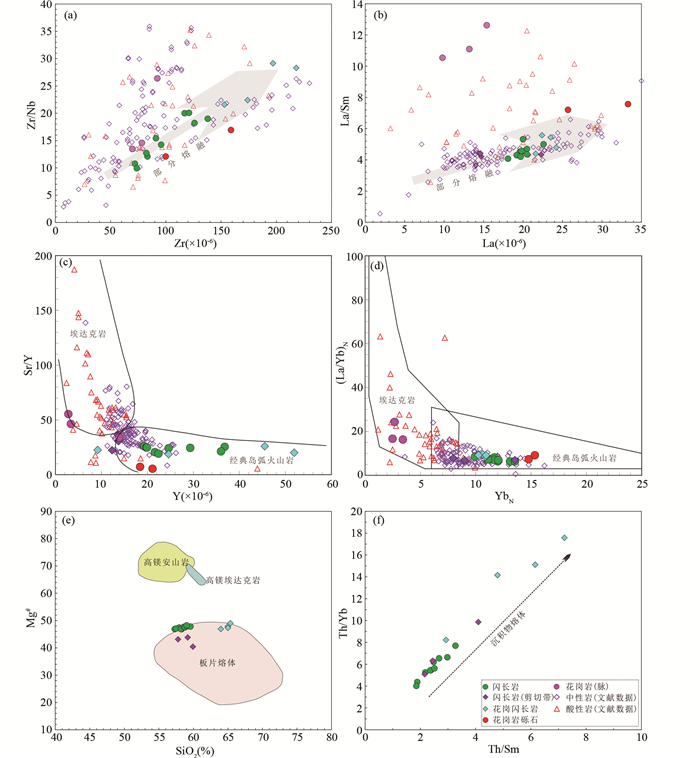
|
图 10 朗县杂岩晚白垩世早期岩浆岩Zr/Nb-Zr (a,Geng et al., 2009)、La/Sm-La (b)、Sr/Y-Y (c,Defant and Drummond, 1990; Castillo et al., 1999)、(La/Yb)N-YbN (d,Martin, 1999)、Mg#-SiO2 (e,Rapp et al., 1999)和Th/Yb-Th/Sm (f,Guo et al., 2007)关系图解 Fig. 10 Plots of Zr/Nb vs. Zr diagram (a, Geng et al., 2009), La/Sm vs. La (b), Sr/Y vs. Y diagram (c, Defant and Drummond, 1990; Castille et al., 1999), (La/Yb)N vs. YbN (d, Martin, 1999), Mg# vs. SiO2 (e, Rapp et al., 1999) and Th/Yb vs. Th/Sm (f, Guo et al., 2007) for the early Late Cretaceous magmatic rocks of Langxian Complex of eastern Gangdese batholith |
闪长岩和花岗闪长岩在微量元素组成等方面略有区别,包括1)闪长岩具有相对较高的石榴子石相容元素Sc(≥11.9×10-6);2)锆饱和温度显示闪长岩(平均值为702℃)明显低于花岗闪长岩(平均值为773℃);3)花岗闪长岩具有较高的Th含量和稀土总量;4)花岗闪长岩明显亏损Ti,Eu负异常(Eu/Eu*=0.61~0.66),暗示存在富Ti矿物和斜长石的分离结晶作用。以上差异暗示闪长岩和花岗闪长岩的岩浆源区形成深度不同且源区受板片流体和沉积物熔体交代的程度也有所区别。
综合以上信息,朗县杂岩中出露的晚白垩世早期闪长岩和花岗闪长岩是受俯冲板片流体和大洋沉积物熔体共同交代的地幔楔部分熔融形成,闪长岩岩浆源区深度较浅,受板片流体的交代较多,花岗闪长岩岩浆源区深度较深,受沉积物熔体交代程度较高,之后经历了富Ti矿物和斜长石的分离结晶作用。
本文将朗县杂岩晚白垩世早期花岗岩依据其主量和微量元素组成进一步划分为两类,第一类花岗岩(T1075-2和T1075-3)属于低钾钙碱性系列,Na2O含量高(4.81%和4.58%)、K2O含量低(1.49%和1.18%)(图 5c),Na2O/K2O较高,均>3(图 5d);稀土总量较高,具有明显的Eu负异常(Eu/Eu*=0.35和0.40);Sr/Y低(5.45和7.17)(表 2)。该类花岗岩的主量元素与闪长岩和花岗闪长岩具有较好的线性演化关系(图 4),可以由上述的闪长岩和花岗闪长岩岩浆进一步演化形成。
第二类花岗岩(T0938-D和T0883-LG)属于高钾钙碱性系列,Na2O含量低(2.58%~2.67%)、K2O含量高(5.64%~5.94%)(图 5c),Na2O/K2O较低,均 < 1;铝饱和指数(A/CNK=1.01~1.02),刚玉分子数为0.38%~0.53%,稀土总量较低,具有非常弱的Eu负异常(Eu/Eu*=0.88~1.12),此外Sr/Y(33.8~55.4)较高(表 2),还发现有角闪石矿物,总体显示I型花岗岩的特征。该类花岗岩的稀土总量明显低于本文的中酸性岩浆岩,不符合同一岩浆体系稀土元素丰度越到酸性岩越高的演化趋势,因此不可能是其进一步分异演化形成,表明其岩浆源区不同与第一类花岗岩。锆石Hf同位素特征显示εHf(t)=+4.1~+10.8,亏损地幔模式年龄(tDM)为330~610Ma;此外全岩εNd(t)(+0.8)明显偏低(图 9a, b),一阶段模式年龄为tDM1=632Ma。综合以上信息,第二类花岗岩(脉)为幔源基性岩浆底侵到新生的下地壳导致其部分熔融形成。
5.3 地球动力学背景冈底斯岩基晚白垩世早期强烈的岩浆作用形成于新特提斯洋北向俯冲的大背景下(Wen et al., 2008a, b; Zhang et al., 2010, 2014; 管琪等, 2010, 2011; Jiang et al., 2012, 2014; Ji et al., 2009, 2014; Ma et al., 2013a, b, c; Zheng et al., 2014; Xu et al., 2015; 叶丽娟等, 2015; 唐演等, 2019; 徐倩等, 2019b; Wang et al., 2021; 高家昊等, 2017, 2020),但是具体的俯冲过程或动力学机制主要存在三种不同的模式:(1)新特提斯洋平板(低角度)俯冲(Coulon et al., 1986; Wen et al., 2008a, b),通常平板俯冲会导致地幔楔物质被挤出使得在俯冲带中地幔楔物质变少,因而较难产出幔源的基性岩浆(Gutscher and Peacock, 2003; Kay et al., 2005; Li and Li, 2007; Ramos and Folguera, 2009),这与晚白垩世早期报道的大量基性岩浆岩不符(管琪等, 2010, 2011; Ma et al., 2013a, b, c; Ji et al., 2014; Zhang et al., 2014; Xu et al., 2015; 叶丽娟等, 2015; 高家昊等, 2020);(2)新特提斯洋洋脊俯冲(Zhang et al., 2010; 管琪等, 2011; Zhang et al., 2014),该模式对于解释具有高温特征的埃达克质紫苏花岗岩较为合理,但晚白垩世早期岩浆作用近平行于雅鲁藏布江缝合带呈东西向带状展布同时并没有向北迁移的趋势,与洋脊俯冲模型的预测不符; (3)俯冲的新特提斯洋板片回撤(Ma et al., 2013a, b; 叶丽娟等, 2015),该模式较合理的解释了晚白垩世时期强烈的岩浆作用和出露的各种类型的岩浆岩,但未深入考虑冈底斯岩基早白垩世的岩浆作用及其动力学背景。
在考虑晚白垩世早期岩浆作用的动力学机制时,早白垩世的构造背景也值得参考,越来越来多的证据表明冈底斯岩基存在早白垩世岩浆作用(Zhu et al., 2009a; Wu et al., 2010; 王莉等, 2013; 王海涛等, 2020; 李广旭等, 2021),该时期新特提斯洋的俯冲角度较陡且有大量流体和沉积物的参与(Zhu et al., 2009a; 王莉等, 2013; 王海涛等, 2020; 李广旭等, 2021)。此外,拉萨地块岩浆作用由北向南整体显示逐渐年轻的趋势(Zhu et al., 2011);在早白垩世日喀则弧前盆地形成时具有强烈的伸展作用(曾令森等, 2017),表明在新特提斯洋北向俯冲过程中经历了海沟后撤(曾令森等, 2017; Kapp and DeCelles, 2019)。综合以上信息,新特提斯洋板片在早白垩世以高角度俯冲,晚白垩世早期其俯冲深度达到临界点,由于重力和浮力等因素开始发生板片回撤或海沟后撤(Chung et al., 2005; Ma et al., 2013a),回撤过程中导致其自身发生减压熔融形成基性原始母岩浆,伴随着软流圈物质上涌,使得经混合熔流体(大洋沉积物+板片流体)交代过的上覆地幔楔和增厚下地壳发生部分熔融,形成了晚白垩世一系列具有亏损特征的中基性和埃达克质岩浆岩;同时软流圈地幔的上涌和对流提供了足够的热并导致俯冲洋壳的部分熔融从而形成埃达克质紫苏花岗岩。随后这些中基性的岩浆进一步侵位到下地壳后导致其发生部分熔融并发生不同程度的分离结晶作用,形成了具有新生地壳性质的花岗质岩石。
6 结论(1) 朗县杂岩中发育晚白垩世早期(92~87Ma)的闪长岩、花岗闪长岩和花岗岩(脉),属于冈底斯岩基晚白垩世“岩浆爆发”时期的产物,其岩浆源区明显亏损但具有不均一性,岩浆作用的形式复杂多样。
(2) 闪长岩和花岗闪长岩为俯冲板片流体和大洋沉积物熔体共同交代的地幔楔部分熔融形成,闪长岩岩浆源区形成深度较浅且受板片流体的交代较多,花岗闪长岩岩浆源区的深度较深,受沉积物熔体交代程度较高,之后经历了富Ti矿物和斜长石的分离结晶作用。
(3) 花岗岩进一步划分为富钠和富钾两类,第一类花岗岩由同期的中酸性岩浆进一步演化形成,第二类花岗岩则为新生的下地壳的部分熔融形成。
(4) 冈底斯岩基晚白垩世早期岩浆作用以中基性的镁铁质岩浆作用为主,是在早白垩世新特提斯洋持续陡俯冲之后,在晚白垩世早期发生了板片回撤引发了大规模的岩浆作用。
致谢 感谢中国地质大学(北京)赵志丹教授和中国地质科学院地质研究所贺振宇研究员的细致审稿,提出诸多建设性修改意见。
Aitchison JC, Davis AM, Zhu BD and Luo H. 2002. New constraints on the India-Asia collision: The Lower Miocene gangrinboche conglomerates, Yarlung Tsangpo suture zone, SE Tibet. Journal of Asian Earth Sciences, 21(3): 251-263 DOI:10.1016/S1367-9120(02)00037-8
|
Blichert-Toft J and Albarède F. 1997. The Lu-Hf isotope geochemistry of chondrites and the evolution of the mantle-crust system. Earth and Planetary Science Letters, 148(1-2): 243-258 DOI:10.1016/S0012-821X(97)00040-X
|
Castillo PR, Janney PE and Solidum RU. 1999. Petrology and geochemistry of Camiguin Island, southern Philippines: Insights to the source of adakites and other lavas in a complex arc setting. Contributions to Mineralogy and Petrology, 134(1): 33-51 DOI:10.1007/s004100050467
|
Chen FK, Siebel W, Satir M, Terzioglu M and Saka K. 2002. Geochronology of the Karadere basement (NW Turkey) and implications for the geological evolution of the Istanbul zone. International Journal of Earth Sciences, 91(3): 469-481 DOI:10.1007/s00531-001-0239-6
|
Chen FK, Li XH, Wang XL, Li QL and Siebel W. 2007. Zircon age and Nd-Hf isotopic composition of the Yunnan Tethyan belt, southwestern China. International Journal of Earth Sciences, 96(6): 1179-1194 DOI:10.1007/s00531-006-0146-y
|
Chengdu Institute of Geology and Mineral Resources (CIGMR). 2004. Geological Map of Tibetan Plateau and Adjacent Areas. Chengdu: Chengdu Map Publishing House (in Chinese)
|
Chung SL, Liu DY, Ji JQ, Chu MF, Lee HY, Wen DJ, Lo CH, Lee TY, Qian Q and Zhang Q. 2003. Adakites from continental collision zones: Melting of thickened lower crust beneath southern Tibet. Geology, 31(11): 1021-1024 DOI:10.1130/G19796.1
|
Chung SL, Chu MF, Zhang YQ, Xie YW, Lo CH, Lee TY, Lan CY, Li XH, Zhang Q and Wang YZ. 2005. Tibetan tectonic evolution inferred from spatial and temporal variations in post-collisional magmatism. Earth-Science Reviews, 68(3-4): 173-196
|
Chung SL, Chu MF, Ji JQ, O'Reilly SY, Pearson NJ, Liu DY, Lee TY and Lo CH. 2009. The nature and timing of crustal thickening in Southern Tibet: Geochemical and zircon Hf isotopic constraints from post-collisional adakites. Tectonophysics, 477(1-2): 36-48 DOI:10.1016/j.tecto.2009.08.008
|
Coulon C, Maluski H, Bollinger C and Wang S. 1986. Mesozoic and Cenozoic volcanic rocks from central and southern Tibet: 39Ar-40Ar dating, petrological characteristics and geodynamical significance. Earth and Planetary Science Letters, 79(3-4): 281-302 DOI:10.1016/0012-821X(86)90186-X
|
Debon F, Le Fort P, Sheppard SMF and Sonet J. 1986. The four plutonic belts of the Transhimalaya-Himalaya: A chemical, mineralogical, isotopic, and chronological synthesis along a Tibet-Nepal section. Journal of Petrology, 27(1): 219-250 DOI:10.1093/petrology/27.1.219
|
Defant MJ and Drummond MS. 1990. Derivation of some modern arc magmas by melting of young subducted lithosphere. Nature, 347(6294): 662-665 DOI:10.1038/347662a0
|
Ding L, Kapp P, Zhong DL and Deng WM. 2003. Cenozoic volcanism in Tibet: Evidence for a transition from oceanic to continental subduction. Journal of Petrology, 44(10): 1833-1865 DOI:10.1093/petrology/egg061
|
Dong HW, Xu ZQ, Zhou X, Ba DZ, Li HQ, Yi ZY, Chen XJ, Ma XX and Wu C. 2016. Active timing and tectonic evolution of the eastern segment of the great counter thrust in the northern margin of the Himalayan Orogen belt. Acta Geologica Sinica, 90(11): 3011-3022 (in Chinese with English abstract)
|
Dong X, Zhang ZM, Liu F, He ZY and Lin YH. 2014. Late Paleozoic intrusive rocks from the southeastern Lhasa terrane, Tibetan Plateau, and their Late Mesozoic metamorphism and tectonic implications. Lithos, 198-199: 249-262 DOI:10.1016/j.lithos.2014.04.001
|
Gao JH, Zeng LS, Guo CL, Li QL and Wang YY. 2017. Late Cretaceous tectonics and magmatism in Gangdese batholith, Southern Tibet: A record from the mafic-dioritic dike swarms within the Baidui Complex, Lhasa. Acta Petrologica Sinica, 33(8): 2412-2436 (in Chinese with English abstract)
|
Gao JH, Zeng LS, Gao LE, Zhao LH, Wang YY and Wang YF. 2020. Geochemical characteristics and petrogenesis of Late Cretaceous hypersthene-bearing intrusive rocks in the Gangdese batholith, southern Tibet. Acta Petrologica Sinica, 36(9): 2667-2700 (in Chinese with English abstract) DOI:10.18654/1000-0569/2020.09.05
|
Geng QR, Sun ZM, Pan GT, Zhu DC and Wang LQ. 2009. Origin of the Gangdise (Transhimalaya) Permian arc in southern Tibet: Stratigraphic and volcanic geochemical constraints. Island Arc, 18(3): 467-487 DOI:10.1111/j.1440-1738.2009.00664.x
|
Griffin WL, Pearson NJ, Belousova E, Jackson SE, Van Achterbergh E, O'Reilly SY and Shee SR. 2000. The Hf isotope composition of cratonic mantle: LAM-MC-ICPMS analysis of zircon megacrysts in kimberlites. Geochimica et Cosmochimica Acta, 64(1): 133-147 DOI:10.1016/S0016-7037(99)00343-9
|
Guan Q, Zhu DC, Zhao ZD, Zhang LL, Liu M, Li XW, Yu F and Mo XX. 2010. Late Cretaceous adakites in the eastern segment of the Gangdese belt, southern Tibet: Products of Neo-Tethyan ridge subduction?. Acta Petrologica Sinica, 26(7): 2165-2179 (in Chinese with English abstract)
|
Guan Q, Zhu DC, Zhao ZD, Dong GC, Mo XX, Liu YS, Hu ZC and Yuan HL. 2011. Zircon U-Pb chronology, geochemistry of the Late Cretaceous mafic magnatism in the southern Lhasa Terrane and its implications. Acta Petrologica Sinica, 27(7): 2083-2094 (in Chinese with English abstract)
|
Guan Q, Zhu DC, Zhao ZD, Dong GC, Zhang LL, Li XW, Liu M, Mo XX, Liu YS and Yuan HL. 2012. Crustal thickening prior to 38Ma in southern Tibet: Evidence from lower crust-derived adakitic magmatism in the Gangdese Batholith. Gondwana Research, 21(1): 88-99 DOI:10.1016/j.gr.2011.07.004
|
Guo ZF, Wilson M and Liu JQ. 2007. Post-collisional adakites in South Tibet: Products of partial melting of subduction-modified lower crust. Lithos, 96(1-2): 205-224 DOI:10.1016/j.lithos.2006.09.011
|
Guo ZF and Wilson M. 2019. Late Oligocene-Early Miocene transformation of postcollisional magmatism in Tibet. Geology, 47(8): 776-780 DOI:10.1130/G46147.1
|
Gutscher MA and Peacock SM. 2003. Thermal models of flat subduction and the rupture zone of great subduction earthquakes. Journal of Geophysical Research: Solid Earth, 108(B1): ESE 2-1-ESE 2-16 DOI:10.1029/2001JB000787
|
He SD, Kapp P, DeCelles PG, Gehrels GE and Heizler M. 2007. Cretaceous-Tertiary geology of the Gangdese Arc in the Linzhou area, southern Tibet. Tectonophysics, 433(1-4): 15-37 DOI:10.1016/j.tecto.2007.01.005
|
Hou KJ, Li YH, Zou TR, Qu XM, Shi YR and Xie GQ. 2007. Laser ablation-MC-ICP-MS technique for Hf isotope microanalysis of zircon and its geological applications. Acta Petrologica Sinica, 23(10): 2595-2604 (in Chinese with English abstract)
|
Hou ZQ, Gao YF, Qu XM, Rui ZY and Mo XX. 2004. Origin of adakitic intrusives generated during Mid-Miocene east-west extension in southern Tibet. Earth and Planetary Science Letters, 220(1-2): 139-155 DOI:10.1016/S0012-821X(04)00007-X
|
Hou ZQ, Duan LF, Lu YJ, Zheng YC, Zhu DC, Yang ZM, Yang ZS, Wang BD, Pei YR, Zhao ZD and McCuaig TC. 2015. Lithospheric architecture of the Lhasa Terrane and its control on ore deposits in the Himalayan-Tibetan Orogen. Economic Geology, 110(6): 1541-1575 DOI:10.2113/econgeo.110.6.1541
|
Huang Y, Zhao ZD, Zhang FQ, Zhu DC, Dong GC, Zhou S and Mo XX. 2010. Geochemistry and implication of the Gangdese batholiths from Renbu and Lhasa areas in southern Gangdese, Tibet. Acta Petrologica Sinica, 26(10): 3131-3142 (in Chinese with English abstract)
|
Jacobsen SB and Wasserburg GJ. 1980. Sm-Nd isotopic evolution of chondrites. Earth and Planetary Science Letters, 50(1): 139-155 DOI:10.1016/0012-821X(80)90125-9
|
Ji WQ, Wu FY, Chung SL, Li JX and Liu CZ. 2009. Zircon U-Pb geochronology and Hf isotopic constraints on petrogenesis of the Gangdese batholith, southern Tibet. Chemical Geology, 262(3-4): 229-245 DOI:10.1016/j.chemgeo.2009.01.020
|
Ji WQ, Wu FY, Liu CZ and Chung SL. 2009. Geochronology and petrogenesis of granitic rocks in Gangdese batholith, southern Tibet. Science in China (Series D), 52(9): 1240-1261 DOI:10.1007/s11430-009-0131-y
|
Ji WQ, Wu FY, Chung SL and Liu CZ. 2012a. Identification of Early Carboniferous granitoids from southern Tibet and implications for terrane assembly related to the Paleo-Tethyan evolution. The Journal of Geology, 120(5): 531-541 DOI:10.1086/666742
|
Ji WQ, Wu FY, Liu CZ and Chung SL. 2012b. Early Eocene crustal thickening in southern Tibet: New age and geochemical constraints from the Gangdese batholith. Journal of Asian Earth Sciences, 53: 82-95 DOI:10.1016/j.jseaes.2011.08.020
|
Ji WQ, Wu FY, Chung SL and Liu CZ. 2014. The Gangdese magmatic constraints on a latest Cretaceous lithospheric delamination of the Lhasa terrane, southern Tibet. Lithos, 210-211: 168-180 DOI:10.1016/j.lithos.2014.10.001
|
Jiang ZQ, Wang Q, Li ZX, Wyman DA, Tang GJ, Jia XH and Yang YH. 2012. Late Cretaceous (ca. 90Ma) adakitic intrusive rocks in the Kelu area, Gangdese belt (southern Tibet): Slab melting and implications for Cu-Au mineralization. Journal of Asian Earth Sciences, 53: 67-81 DOI:10.1016/j.jseaes.2012.02.010
|
Jiang ZQ, Wang Q, Wyman DA, Li ZX, Yang JH, Shi XB, Ma L, Tang GJ, Gou GN, Jia XH and Guo HF. 2014. Transition from oceanic to continental lithosphere subduction in southern Tibet: Evidence from the Late Cretaceous-Early Oligocene (ca.91~30Ma) intrusive rocks in the Chanang-Zedong area, southern Gangdese. Lithos, 196-197: 213-231 DOI:10.1016/j.lithos.2014.03.001
|
Kang ZQ, Xu JF, Chen JL, Wang BD and Dong YH. 2010. The geochronology of Sangri Group volcanic rocks in Tibet: Constraints from later Mamen intrusions. Geochimica, 39(6): 520-530 (in Chinese with English abstract)
|
Kang ZQ, Xu JF, Wilde SA, Feng ZH, Chen JL, Wang BD, Fu WC and Pan HB. 2014. Geochronology and geochemistry of the Sangri Group volcanic rocks, Southern Lhasa Terrane: Implications for the early subduction history of the Neo-Tethys and Gangdese magmatic arc. Lithos, 200-201: 157-168 DOI:10.1016/j.lithos.2014.04.019
|
Kapp P, Murphy MA, Yin A, Harrison TM, Ding L and Guo JH. 2003. Mesozoic and Cenozoic tectonic evolution of the Shiquanhe area of western Tibet. Tectonics, 22(4): 1029
|
Kapp P, Yin A, Harrison TM and Ding L. 2005. Cretaceous-Tertiary shortening, basin development, and volcanism in central Tibet. GSA Bulletin, 117(7-8): 865-878
|
Kapp P and DeCelles PG. 2019. Mesozoic-Cenozoic geological evolution of the Himalayan-Tibetan orogen and working tectonic hypotheses. American Journal of Science, 319(3): 159-254 DOI:10.2475/03.2019.01
|
Kay SM, Godoy E and Kurtz A. 2005. Episodic arc migration, crustal thickening, subduction erosion, and magmatism in the south-central Andes. GSA Bulletin, 117(1-2): 67-88
|
Keto LS and Jacobsen SB. 1987. Nd and Sr isotopic variations of Early Paleozoic oceans. Earth and Planetary Science Letters, 84(1): 27-41 DOI:10.1016/0012-821X(87)90173-7
|
Langmuir CH, Vocke Jr RD, Hanson GN and Hart SR. 1978. A general mixing equation with applications to Icelandic basalts. Earth and Planetary Science Letters, 37(3): 380-392 DOI:10.1016/0012-821X(78)90053-5
|
Leier AL, Kapp P, Gehrels GE and DeCelles PG. 2007. Detrital zircon geochronology of Carboniferous-Cretaceous strata in the Lhasa terrane, Southern Tibet. Basin Research, 19(3): 361-378 DOI:10.1111/j.1365-2117.2007.00330.x
|
Li GX, Zeng LS, Gao LE, Gao JH and Zhao LH. 2020. Carboniferous magmatic records in the eastern Gangdese batholith, southern Tibet. Acta Petrologica Sinica, 36(10): 3018-3040 (in Chinese with English abstract) DOI:10.18654/1000-0569/2020.10.06
|
Li GX, Zeng LS, Gao LE, Gao JH and Zhao LH. 2021. Early Cretaceous magmatism of the Langxian Complex in the eastern Gangdese batholith, southern Tibet: Neo-Tethys Ocean subduction re-initiation. Acta Petrologica Sinica, 37(10): 2995-3034 (in Chinese with English abstract) DOI:10.18654/1000-0569/2021.10.04
|
Li ZX and Li XH. 2007. Formation of the 1300-km-wide intracontinental orogen and postorogenic magmatic province in Mesozoic South China: A flat-slab subduction model. Geology, 35(2): 179-182 DOI:10.1130/G23193A.1
|
Liu YS, Hu ZC, Zong KQ, Gao CG, Gao S, Xu J and Chen HH. 2010. Reappraisement and refinement of zircon U-Pb isotope and trace element analyses by LA-ICP-MS. Chinese Science Bulletin, 55(15): 1535-1546 DOI:10.1007/s11434-010-3052-4
|
Liu ZC, Ding L, Zhang LY, Wang C, Qiu ZL, Wang JG, Shen XL and Deng XQ. 2018. Sequence and petrogenesis of the Jurassic volcanic rocks (Yeba Formation) in the Gangdese arc, southern Tibet: Implications for the Neo-Tethyan subduction. Lithos, 312-313: 72-98 DOI:10.1016/j.lithos.2018.04.026
|
Ludwig KR. 2003. ISOPLOT 3.00:A geochronological toolkit for microsoft excel. Berkeley: Berkeley Geochronology Center
|
Ma L, Wang Q, Li ZX, Wyman DA, Jiang ZQ, Yang JH, Gou GN and Guo HF. 2013a. Early Late Cretaceous (ca. 93Ma) norites and hornblendites in the Milin area, eastern Gangdese: Lithosphere-asthenosphere interaction during slab roll-back and an insight into early Late Cretaceous (ca. 100~80Ma) magmatic "flare-up" in southern Lhasa (Tibet). Lithos, 172-173: 17-30 DOI:10.1016/j.lithos.2013.03.007
|
Ma L, Wang Q, Wyman DA, Jiang ZQ, Yang JH, Li QL, Gou GN and Guo HF. 2013b. Late Cretaceous crustal growth in the Gangdese area, southern Tibet: Petrological and Sr-Nd-Hf-O isotopic evidence from Zhengga diorite-gabbro. Chemical Geology, 349-350: 54-70 DOI:10.1016/j.chemgeo.2013.04.005
|
Ma L, Wang Q, Wyman DA, Li ZX, Jiang ZQ, Yang JH, Gou GN and Guo HF. 2013c. Late Cretaceous (100~89Ma) magnesian charnockites with adakitic affinities in the Milin area, eastern Gangdese: Partial melting of subducted oceanic crust and implications for crustal growth in southern Tibet. Lithos, 175-176: 315-332 DOI:10.1016/j.lithos.2013.04.006
|
Ma XX, Meert JG, Xu ZQ and Yi ZY. 2018. Late Triassic intra-oceanic arc system within Neotethys: Evidence from cumulate appinite in the Gangdese belt, southern Tibet. Lithosphere, 10(4): 545-565 DOI:10.1130/L682.1
|
Ma XX, Xu ZQ, Zhao ZB and Yi ZY. 2020. Identification of a new source for the Triassic Langjiexue Group: Evidence from a gabbro-diorite complex in the Gangdese magmatic belt and zircon microstructures from sandstones in the Tethyan Himalaya, southern Tibet. Geosphere, 16(1): 407-434 DOI:10.1130/GES02154.1
|
Mahoney JJ, Frei R, Tejada MLG, Mo XX, Leat PT and Nägler TF. 1998. Tracing the Indian Ocean mantle domain through time: Isotopic results from old West Indian, East Tethyan, and South Pacific seafloor. Journal of Petrology, 39(7): 1285-1306 DOI:10.1093/petroj/39.7.1285
|
Maniar PD and Piccoli PM. 1989. Tectonic discrimination of granitoids. GSA Bulletin, 101(5): 635-643 DOI:10.1130/0016-7606(1989)101<0635:TDOG>2.3.CO;2
|
Martin H. 1999. Adakitic magmas: Modern analogues of Archaean granitoids. Lithos, 46(3): 411-429 DOI:10.1016/S0024-4937(98)00076-0
|
McDonough WF and Sun SS. 1995. The Composition of the Earth. Chemical Geology, 120(3-4): 223-253 DOI:10.1016/0009-2541(94)00140-4
|
Middlemost EAK. 1994. Naming materials in the magma/igneous rock system. Earth-Science Reviews, 37(3-4): 215-224 DOI:10.1016/0012-8252(94)90029-9
|
Miller CF, McDowell SM and Mapes RW. 2003. Hot and cold granites? Implications of zircon saturation temperatures and preservation of inheritance. Geology, 31(6): 529-532 DOI:10.1130/0091-7613(2003)031<0529:HACGIO>2.0.CO;2
|
Mo XX, Zhao ZD, Deng JF, Dong GC, Zhou S, Guo TY, Zhang SQ and Wang LL. 2003. Response of volcanism to the India-Asia collision. Earth Science Frontiers, 10(3): 135-148 (in Chinese with English abstract)
|
Othman DB, White WM and Patchett J. 1989. The geochemistry of marine sediments, island arc magma genesis, and crust-mantle recycling. Earth and Planetary Science Letters, 94(1-2): 1-21 DOI:10.1016/0012-821X(89)90079-4
|
Pearce JA, Kempton PD, Nowell GM and Noble SR. 1999. Hf-Nd element and isotope perspective on the nature and provenance of mantle and subduction components in Western Pacific arc-basin systems. Journal of Petrology, 40(11): 1579-1611 DOI:10.1093/petroj/40.11.1579
|
Plank T and Langmuir CH. 1998. The chemical composition of subducting sediment and its consequences for the crust and mantle. Chemical Geology, 145(3-4): 325-394 DOI:10.1016/S0009-2541(97)00150-2
|
Quidelleur X, Grove M, Lovera OM, Harrison TM, Yin A and Ryerson FJ. 1997. Thermal evolution and slip history of the Renbu Zedong Thrust, southeastern Tibet. Journal of Geophysical Research: Solid Earth, 102(B2): 2659-2679 DOI:10.1029/96JB02483
|
Ramos VA and Folguera A. 2009. Andean flat-slab subduction through time. In: Murphy JB, Keppie JD and Hynes AJ (eds. ). Ancient Orogens and Modern Analogues. London: Geological Society, 31-54
|
Rapp RP, Shimizu N, Norman MD and Applegate GS. 1999. Reaction between slab-derived melts and peridotite in the mantle wedge: Experimental constraints at 3.8GPa.. Chemical Geology, 160(4): 335-356 DOI:10.1016/S0009-2541(99)00106-0
|
Rollinson HR. 1993. Using Geochemical Data: Evaluation, Presentation, and Interpretation. New York: Longman Scientific and Technical, 1-352
|
Söderlund U, Patchett PJ, Vervoort JD and Isachsen CE. 2004. The 176Lu decay constant determined by Lu-Hf and U-Pb isotope systematics of Precambrian mafic intrusions. Earth and Planetary Science Letters, 219(3-4): 311-324 DOI:10.1016/S0012-821X(04)00012-3
|
Steiger RH and Jäger E. 1977. Subcommission on geochronology: Convention on the use of decay constants in geo-and cosmochronology. Earth and Planetary Science Letters, 36(3): 359-362 DOI:10.1016/0012-821X(77)90060-7
|
Tang Y, Zhao ZD, Qi NY, Wang ZZ, Liu D, Luan JY and Zhu DC. 2019. Geochemistry and petrogenesis of Late Cretaceous Namling gabbro and dykes in Gangdese batholith, Tibet. Acta Petrologica Sinica, 35(2): 387-404 (in Chinese with English abstract) DOI:10.18654/1000-0569/2019.02.08
|
Tapponnier P, Mercier JL, Armijo R, Tonglin H and Ji Z. 1981. Field evidence for active normal faulting in Tibet. Nature, 294(5840): 410-414 DOI:10.1038/294410a0
|
Vervoort JD and Blichert-Toft J. 1999. Evolution of the depleted mantle: Hf isotope evidence from juvenile rocks through time. Geochimica et Cosmochimica Acta, 63(3-4): 533-556 DOI:10.1016/S0016-7037(98)00274-9
|
Wang HT, Zeng LS, Xu CP, Gao JH, Zhao LH, Wang YF and Hu ZP. 2020. Petrogenesis and geodynamic significances of Late Jurassic-Cretaceous intrusion in the Mainling area, eastern Gangdese, southern Tibet. Acta Petrologica Sinica, 36(10): 3041-3062 (in Chinese with English abstract) DOI:10.18654/1000-0569/2020.10.07
|
Wang L, Zeng LS, Gao LE and Chen ZY. 2013. Early Cretaceous high Mg# and high Sr/Y clinopyroxene-bearing diorite in the southeast Gangdese batholith, Southern Tibet. Acta Petrologica Sinica, 29(6): 1977-1994 (in Chinese with English abstract)
|
Wang ZZ, Zhao ZD, Li XP, Asimow PD, Liu D, Mo XX, Qi NY, Tang Y, Wang Q, Zhu DC, Zhang LL and Sheikh L. 2021. Late Cretaceous adakitic and A-type granitoids in Chanang, southern Tibet: Implications for Neo-Tethyan slab rollback. Gondwana Research, 96: 89-104 DOI:10.1016/j.gr.2021.04.007
|
Watson EB and Harrison TM. 1983. Zircon saturation revisited: Temperature and composition effects in a variety of crustal magma types. Earth and Planetary Science Letters, 64(2): 295-304 DOI:10.1016/0012-821X(83)90211-X
|
Wen DR, Liu DY, Chung SL, Chu MF, Ji JQ, Zhang Q, Song B, Lee TY, Yeh MW and Lo CH. 2008a. Zircon SHRIMP U-Pb ages of the Gangdese batholith and implications for Neotethyan subduction in southern Tibet. Chemical Geology, 252(3-4): 191-201 DOI:10.1016/j.chemgeo.2008.03.003
|
Wen DR, Chung SL, Song B, Iizuka Y, Yang HJ, Ji JQ, Liu DY and Gallet S. 2008b. Late Cretaceous Gangdese intrusions of adakitic geochemical characteristics, SE Tibet: Petrogenesis and tectonic implications. Lithos, 105(1-2): 1-11 DOI:10.1016/j.lithos.2008.02.005
|
Wu FY, Ji WQ, Liu CZ and Chung SL. 2010. Detrital zircon U-Pb and Hf isotopic data from the Xigaze fore-arc basin: Constraints on Transhimalayan magmatic evolution in southern Tibet. Chemical Geology, 271(1-2): 13-25 DOI:10.1016/j.chemgeo.2009.12.007
|
Wu XY, Wang Q, Zhu DC, Zhao ZD, Chen Y, Jia LL, Zheng JP and Mo XX. 2013. Origin of the Early Carboniferous granitoids in the southern margin of the Lhasa Terrane and its implication for the opening of the Songdo Tethyan Ocean. Acta Petrologica Sinica, 29(11): 3716-3730 (in Chinese with English abstract)
|
Xu JF and Castillo PR. 2004. Geochemical and Nd-Pb isotopic characteristics of the Tethyan asthenosphere: Implications for the origin of the Indian Ocean mantle domain. Tectonophysics, 393(1-4): 9-27 DOI:10.1016/j.tecto.2004.07.028
|
Xu Q, Zeng LS, Gao JH, Gao LE, Wang YF, Hu ZP and Zhao LH. 2019a. Geochemical characteristics and genesis of the Miocene high Sr/Y intermediate-felsic magmatic rocks in eastern Gangdese batholith, southern Tibet. Acta Petrologica Sinica, 35(6): 1627-1646 (in Chinese with English abstract) DOI:10.18654/1000-0569/2019.06.02
|
Xu Q, Zeng LS, Gao JH, Zhao LH, Wang YF and Hu ZP. 2019b. Geochemical characteristics and genesis of the Songka Late Cretaceous adakitic high-Mg diorite in the southern margin of Gangdese, southern Tibet. Acta Petrologica Sinica, 35(2): 455-471 (in Chinese with English abstract) DOI:10.18654/1000-0569/2019.02.12
|
Xu Q, Zeng LS, Zhao LH, Hu ZP, Wang HT, Shen Y, Wang YY and Wang YF. 2020. Geochemical characteristics and petrogenesis of Miocene high Sr/Y rocks in Xigatze fore-arc basin, southern Tibet. Lithos, 366-367: 105543 DOI:10.1016/j.lithos.2020.105543
|
Xu WC, Zhang HF, Luo BJ, Guo L and Yang H. 2015. Adakite-like geochemical signature produced by amphibole-dominated fractionation of arc magmas: An example from the Late Cretaceous magmatism in Gangdese belt, south Tibet. Lithos, 232: 197-210 DOI:10.1016/j.lithos.2015.07.001
|
Ye LJ, Zhao ZD, Liu D, Zhu DC, Dong GC, Mo XX, Hu ZC and Liu YS. 2015. Late Cretaceous diabase and granite dike in Namling, Tibet: Petrogenesis and implications for extension. Acta Petrologica Sinica, 31(5): 1298-1312 (in Chinese with English abstract)
|
Yin A and Harrison TM. 2000. Geologic evolution of the Himalayan-Tibetan orogen. Annual Review of Earth and Planetary Sciences, 28: 211-280 DOI:10.1146/annurev.earth.28.1.211
|
Zeng LS, Gao LE, Guo CL, Hou KJ and Wang Q. 2017. Early Cretaceous forearc extension of the Gangdese continental arc, southern Tibet. Acta Petrologica Sinica, 33(8): 2377-2394 (in Chinese with English abstract)
|
Zhang SQ, Mahoney JJ, Mo XX, Ghazi AM, Milani L, Crawford AJ, Guo TY and Zhao ZD. 2005. Evidence for a widespread Tethyan upper mantle with Indian-Ocean-type isotopic characteristics. Journal of Petrology, 46(4): 829-858 DOI:10.1093/petrology/egi002
|
Zhang ZM, Zhao GC, Santosh M, Wang JL, Dong X and Shen K. 2010. Late Cretaceous charnockite with adakitic affinities from the Gangdese batholith, southeastern Tibet: Evidence for Neo-Tethyan mid-ocean ridge subduction?. Gondwana Research, 17(4): 615-631 DOI:10.1016/j.gr.2009.10.007
|
Zhang ZM, Dong X, Xiang H, He ZY and Liou JG. 2014. Metagabbros of the Gangdese arc root, South Tibet: Implications for the growth of continental crust. Geochimica et Cosmochimica Acta, 143: 268-284 DOI:10.1016/j.gca.2014.01.045
|
Zhang ZM, Ding HX, Dong X and Tian ZL. 2019. Formation and evolution of the Gangdese magmatic arc, southern Tibet. Acta Petrologica Sinica, 35(2): 275-294 (in Chinese with English abstract) DOI:10.18654/1000-0569/2019.02.01
|
Zhao ZD, Mo XX, Dilek Y, Niu YL, DePaolo DJ, Robinson P, Zhu DC, Sun CG, Dong GC, Zhou S, Luo ZH and Hou ZQ. 2009. Geochemical and Sr-Nd-Pb-O isotopic compositions of the post-collisional ultrapotassic magmatism in SW Tibet: Petrogenesis and implications for India intra-continental subduction beneath southern Tibet. Lithos, 113(1-2): 190-212 DOI:10.1016/j.lithos.2009.02.004
|
Zheng YC, Hou ZQ, Gong YL, Liang W, Sun QZ, Zhang S, Fu Q, Huang KX, Li QY and Li W. 2014. Petrogenesis of Cretaceous adakite-like intrusions of the Gangdese Plutonic Belt, southern Tibet: Implications for mid-ocean ridge subduction and crustal growth. Lithos, 190-191: 240-263 DOI:10.1016/j.lithos.2013.12.013
|
Zhu DC, Pan GT, Chung SL, Liao ZL, Wang LQ and Li GM. 2008. SHRIMP zircon age and geochemical constraints on the origin of Lower Jurassic volcanic rocks from the Yeba Formation, southern Gangdese, south Tibet. International Geology Review, 50(5): 442-471 DOI:10.2747/0020-6814.50.5.442
|
Zhu DC, Zhao ZD, Pan GT, Lee HY, Kang ZQ, Liao ZL, Wang LQ, Li GM, Dong GC and Liu B. 2009a. Early cretaceous subduction-related adakite-like rocks of the Gangdese Belt, southern Tibet: Products of slab melting and subsequent melt-peridotite interaction?. Journal of Asian Earth Sciences, 34(3): 298-309 DOI:10.1016/j.jseaes.2008.05.003
|
Zhu DC, Mo XX, Niu YL, Zhao ZD, Wang LQ, Liu YS and Wu FY. 2009b. Geochemical investigation of Early Cretaceous igneous rocks along an east-west traverse throughout the central Lhasa Terrane, Tibet. Chemical Geology, 268(3-4): 298-312 DOI:10.1016/j.chemgeo.2009.09.008
|
Zhu DC, Zhao ZD, Niu YL, Mo XX, Chung SL, Hou ZQ, Wang LQ and Wu FY. 2011. The Lhasa Terrane: Record of a microcontinent and its histories of drift and growth. Earth and Planetary Science Letters, 301(1-2): 241-255 DOI:10.1016/j.epsl.2010.11.005
|
Zhu DC, Wang Q, Zhao ZD, Chung SL, Cawood PA, Niu YL, Liu SA, Wu FY and Mo XX. 2015. Magmatic record of India-Asia collision. Scientific Report, 5(1): 14289 DOI:10.1038/srep14289
|
Zhu DC, Wang Q, Chung SL, Cawood PA and Zhao ZD. 2019. Gangdese magmatism in southern Tibet and India-Asia convergence since 120Ma. In: Treloar PJ and Searle MP (eds. ). Himalayan Tectonics: A Modern Synthesis. London: Geological Society, 583-604
|
成都地质矿产研究所. 2004. 青藏高原及邻区地质图. 成都: 成都地图出版社.
|
董汉文, 许志琴, 周信, 巴登珠, 李化启, 易治宇, 陈希节, 马绪宣, 吴婵. 2016. 喜马拉雅造山带北缘大反转逆冲断层(GCT)东段的活动时限及构造演化. 地质学报, 90(11): 3011-3022. DOI:10.3969/j.issn.0001-5717.2016.11.004 |
高家昊, 曾令森, 郭春丽, 李秋立, 王亚莹. 2017. 藏南冈底斯岩基晚白垩世构造岩浆作用: 以拉萨白堆复合岩体中-基性岩脉群为例. 岩石学报, 33(8): 2412-2436. |
高家昊, 曾令森, 高利娥, 赵令浩, 王亚莹, 王亚飞. 2020. 藏南冈底斯岩基晚白垩世含紫苏辉石侵入岩的地球化学特征及其成因探讨. 岩石学报, 36(9): 2667-2700. |
管琪, 朱弟成, 赵志丹, 张亮亮, 刘敏, 李小伟, 于枫, 莫宣学. 2010. 西藏南部冈底斯带东段晚白垩世埃达克岩: 新特提斯洋脊俯冲的产物?. 岩石学报, 26(7): 2165-2179. |
管琪, 朱弟成, 赵志丹, 董国臣, 莫宣学, 刘勇胜, 胡兆初, 袁洪林. 2011. 西藏拉萨地块南缘晚白垩世镁铁质岩浆作用的年代学、地球化学及意义. 岩石学报, 27(7): 2083-2094. |
侯可军, 李延河, 邹天人, 曲晓明, 石玉若, 谢桂青. 2007. LA-MC-ICP-MS锆石Hf同位素的分析方法及地质应用. 岩石学报, 23(10): 2595-2604. DOI:10.3969/j.issn.1000-0569.2007.10.025 |
黄玉, 赵志丹, 张凤琴, 朱弟成, 董国臣, 周肃, 莫宣学. 2010. 西藏冈底斯仁布-拉萨一带花岗岩基的地球化学及其意义. 岩石学报, 26(10): 3131-3142. |
纪伟强, 吴福元, 锺孙霖, 刘传周. 2009. 西藏南部冈底斯岩基花岗岩时代与岩石成因. 中国科学(D辑), 39(7): 849-871. |
康志强, 许继峰, 陈建林, 王保弟, 董彦辉. 2010. 西藏南部桑日群火山岩的时代: 来自晚期马门侵入体的约束. 地球化学, 39(6): 520-530. |
李广旭, 曾令森, 高利娥, 高家昊, 赵令浩. 2020. 藏南冈底斯岩基东段石炭纪岩浆作用记录. 岩石学报, 36(10): 3018-3040. |
李广旭, 曾令森, 高利娥, 高家昊, 赵令浩. 2021. 藏南冈底斯岩基东段朗县杂岩早白垩世岩浆作用: 新特提斯洋二次俯冲. 岩石学报, 37(10): 2995-3034. DOI:10.18654/1000-0569/2021.10.04 |
莫宣学, 赵志丹, 邓晋福, 董国臣, 周肃, 郭铁鹰, 张双全, 王亮亮. 2003. 印度-亚洲大陆主碰撞过程的火山作用响应. 地学前缘, 10(3): 135-148. DOI:10.3321/j.issn:1005-2321.2003.03.013 |
唐演, 赵志丹, 齐宁远, 王珍珍, 刘栋, 栾炅雨, 朱弟成. 2019. 西藏冈底斯岩基南木林晚白垩世岩体和脉岩地球化学与岩石成因. 岩石学报, 35(2): 387-404. |
王海涛, 曾令森, 许翠萍, 高家昊, 赵令浩, 王亚飞, 胡昭平. 2020. 藏南冈底斯岩基东段米林地区晚侏罗世-白垩纪侵入岩的岩石成因和地球动力学意义. 岩石学报, 36(10): 3041-3062. |
王莉, 曾令森, 高利娥, 陈振宇. 2013. 藏南冈底斯岩基东南缘早白垩世高镁-高Sr/Y含单斜辉石闪长岩. 岩石学报, 29(6): 1977-1994. |
吴兴源, 王青, 朱弟成, 赵志丹, 陈越, 贾黎黎, 郑建平, 莫宣学. 2013. 拉萨地体南缘早石炭世花岗岩类的起源及其对松多特提斯洋开启的意义. 岩石学报, 29(11): 3716-3730. |
徐倩, 曾令森, 高家昊, 高利娥, 王亚飞, 胡昭平, 赵令浩. 2019a. 藏南冈底斯岩基东段中新世中酸性高Sr/Y比岩浆岩的地球化学特征及成因探讨. 岩石学报, 35(6): 1627-1646. |
徐倩, 曾令森, 高家昊, 赵令浩, 王亚飞, 胡昭平. 2019b. 西藏南部冈底斯南缘松卡晚白垩世埃达克质高镁闪长岩地球化学特征及其成因. 岩石学报, 35(2): 455-471. |
叶丽娟, 赵志丹, 刘栋, 朱弟成, 董国臣, 莫宣学, 胡兆初, 刘勇胜. 2015. 西藏南木林晚白垩世辉绿岩与花岗质脉岩成因及其揭示的伸展背景. 岩石学报, 31(5): 1298-1312. |
曾令森, 高利娥, 郭春丽, 侯可军, 王倩. 2017. 西藏南部冈底斯大陆弧早白垩纪弧前伸展作用. 岩石学报, 33(8): 2377-2394. |
张泽明, 丁慧霞, 董昕, 田作林. 2019. 冈底斯岩浆弧的形成与演化. 岩石学报, 35(2): 275-294. |
 2021, Vol. 37
2021, Vol. 37


